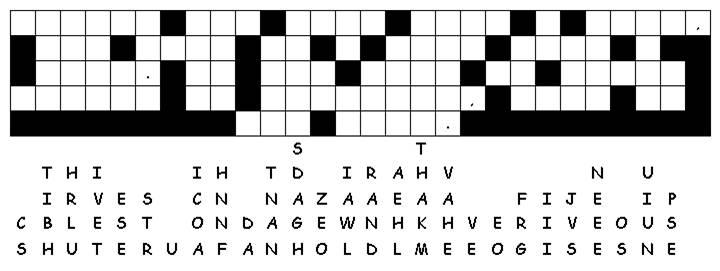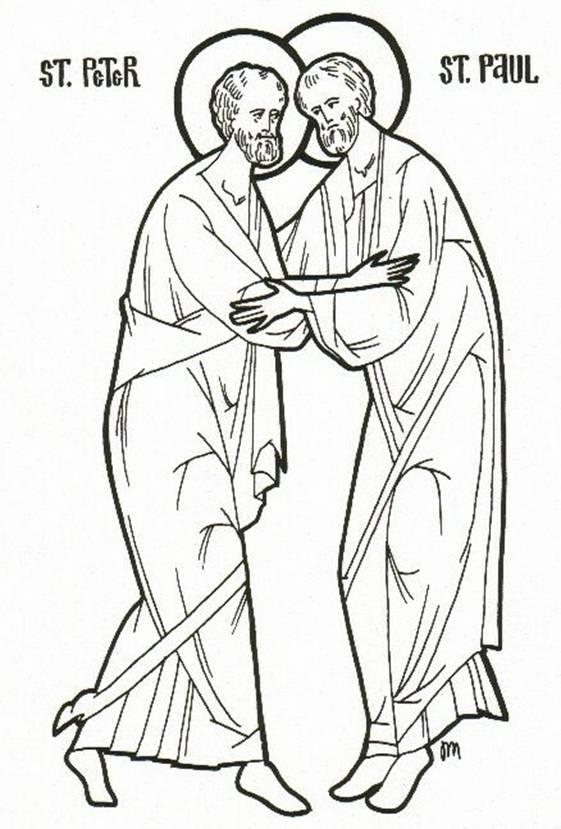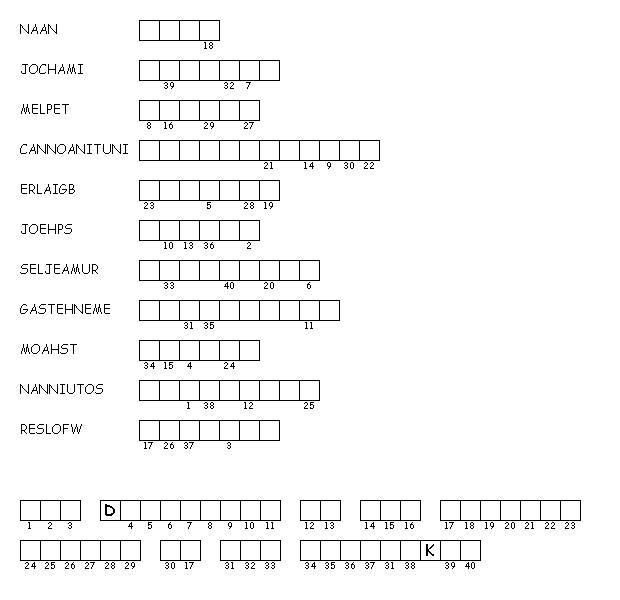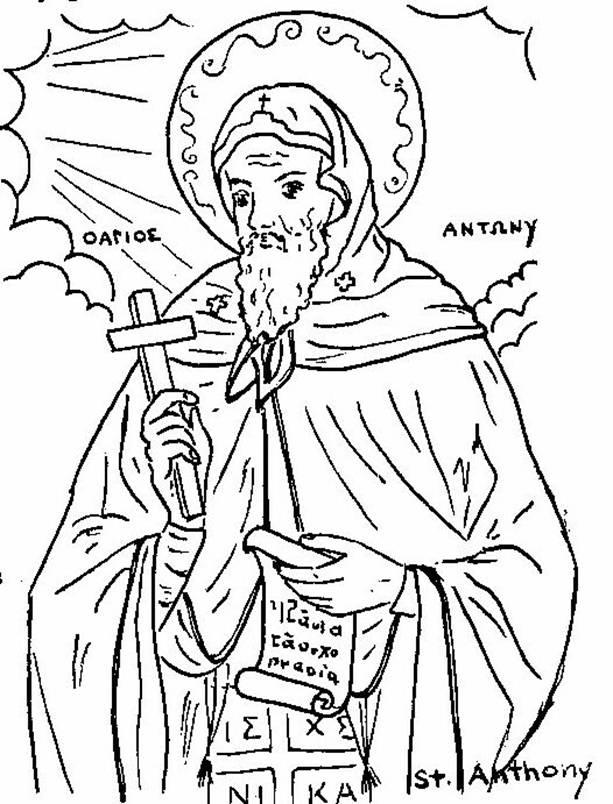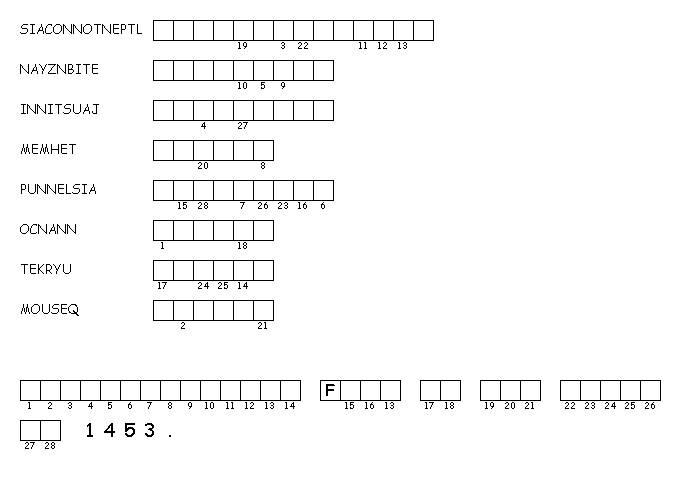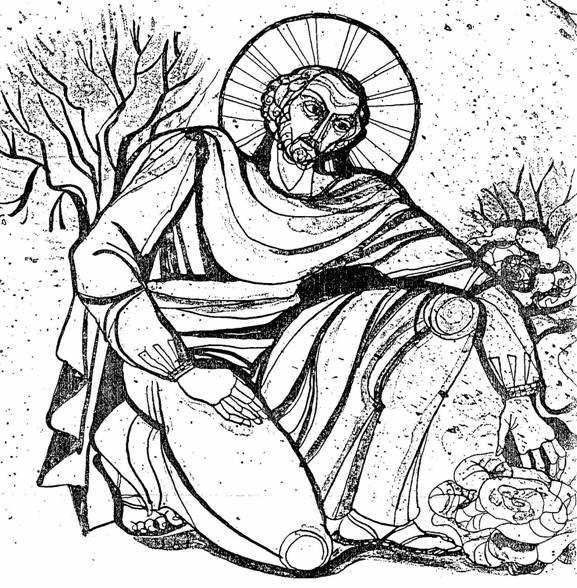Church History Parents' Guide Schedule and Overview
CHURCH HISTORY
PARENTS’ GUIDE
Sample schedule of classes -- type in your own dates for the current year.
Date Topic Special Notes
Sept. 8 Opening Gala Movie Night, entire parish Quo Vadis
Outdoor theater with bonfire
9 Pentecost/Philip & Eunuch
16 Stephen
23 Conversion of Saul
30 Peter and Cornelius
Oct. 7 Council of Jerusalem
14 Spread of Gospel
21 John/Revelation
27 Movie Night (after vespers) Ben Hur
28 Paul and Journeys All Saint’s Party after Church School
in Social Hall – bring costumes
Nov. 4 Paul and Journeys
11 Peter
18 Dormition
25 Persecutions
Dec. 1 St. Nicholas Festival 10AM-12noon Rehearsal of play following
2 St. Nicholas Play Congregation during coffee hour
Nursing Home afterwards
9 Constantine
16 Elevation of the Cross
23 St. Mary of Egypt
30 Canon of Scripture Memory Work: Books of Bible
(Gospels and Acts for ages 3-7)
Theophany jars after Church School
Jan. 6 Athanasius/Creed
Council of Nicea 12:30 PM Three Kings Party
13 Chrysostom/Liturgy Memory Work: Creed
20 Three Hierarchs Homeless Bags after Church School
27 Cyril of Alexandria/Councils
Feb. 3 St. Nina/St. Patrick/Councils
9 Movie night after vespers El Cid
10 Fall of Rome
17 Byzantine Empire/Justinian Memory Work: Trisagion Prayers
(3-5 only thrice holy)
24 Rise of Islam
March 2 Icons/St. John of Damascus Art Day after Church School
9 Monasticism/ St. Anthony/St. Seraphim
16 Cyril and Methodius/ Baptism of Russia
23 St. Gregory Palamas Memory work: Jesus Prayer
30 The Crusades
April 6 Fall of Constantinople
12 Movie Night after vespers Becket or A Man for All Seasons
13 Protestant Reformation
20 Protestant Reformation
- PASCHA – no Church School
- Easter Egg Hunt and Cookout after Liturgy
May 4 Armenia/Antioch
11 Ethiopia/Alexandria
16-18 Camping Trip: No Class
25 Greece/Constantinople Memory Work: “Lord Have Mercy”
5 languages (3-5 only one)
June 1 Serbia, Romania, Bulgaria
8 Japan Rehearsal during opening exercises
15 Ukraine, Russia, OCA Rehearsal during opening exercises
21 Rehearsal after vespers Balailaka on the Onion Dome
Movie night Scarlet and Black
22 End of Year Play Parish and Nursing Home
Awards Presentation
WEEKLY SUPPLEMENTS
Several families have requested in past years a parents’ guide to help them in continuing their children’s Christian education at home and reinforcing what is being taught in Church School. The following constitutes some suggestions you can use in your homes but, be creative! Look at the topics yourselves and you’ll probably think of many even more exciting activities for you and your child(ren) to enjoy together. This is geared to the smaller children (ages 10 and under); older children still have memory work and should begin reading the Scripture lessons and maybe even biographies of some of the saints (e.g. from the church library) of the time period. There is a puzzle with each lesson for the older children plus coloring pages and activities for the younger.
Remember each day to celebrate family prayers in your icon corner and to reread (or retell) the story we read in Church School at least once during the week. Your “home altar” could include icons (Jesus, Mary, family saints?), incense, candles, Bible, a jar of holy water, matches or lighter, prayer book. How about tablecloths or placemats or a piece of fabric or felt of the Liturgical colors to switch out seasonally. And, of course, include displays of specific artwork done by your child during the year for specific feasts and saints.
After the weekly suggestions, look through the stories, coloring icons, recipes, songs, maps, and fact sheets to help you with each week’s “homework”, but don’t ignore the church library, public library (lots of great children’s picture geography books, about every possible country), your own library, and the Internet for even more enrichment.
There is also some memory work for even the youngest children, as well as the older. These can be learned at home and recited in class or during the Opening Exercises, for a prize, of course. Here's a bookmark with all of the memory work for the year for easy reviewing in the car or at home. Line up to print front and back on cardstock and laminate or use clear adhesive sheets, or just print and glue to construction paper!
It is very important even for the very young child to have daily prayers (Do you have a family icon corner? What about setting up one in his room?) and Bible (or Bible story) reading, maybe right after dinner or at bedtime. Do you say grace after each meal? Each day they can practice crossing themselves, lighting candles, burning incense, etc. And on Saturday night, in preparation for Liturgy the next day, what about a time of private confession to the Lord? You could even “pray the hours” on days when you are home: 7 AM (First Hour) thanking God for His light, 9 AM (3rd Hour) thanking Him for His Holy Spirit, 12 Noon (6th Hour) thanking Him for His crucifixion, and 3 PM (9th Hour) praying with the wise thief, “Remember me, O Lord, in thy Kingdom.” Very little time spent, but a habit begun. Don’t forget a Jesse Tree and Advent wreath to bring Nativity closer to home.
In addition, don’t forget our parties, pageants, and the camping trip. These are designed to be part of the curriculum and real learning experiences, but fun as well! The Balalaika on the Onion Dome, performed with puppets and sung, will musically review the entire year for all of us.
RECIPES
CLAYS PAINTS
SALT DOUGH FINGER PAINT (4 WAYS)
2 cups flour Use pudding with food coloring!
1 cup salt Mix liquid starch and food coloring.
about 1 cup water Mix 3 T sugar, ½ cup cornstarch, and
food coloring 2 cups cold water. Cook over
bath oil, vegetable oil, peppermint oil low heat, stirring, till thick.
Mix flour and salt. Add water Pour into muffin tin. Add
slowly and mix with your fingers until food coloring to each cup.
it makes dough. Knead in a few drops
food coloring and a splotch of oil (if SAND PAINT
desired). Store in air-tight container. Add dry tempera paint to corn meal.
Sprinkle over areas “painted” with thinned white glue.
SELF-HARDENING CLAY
1 cup sand Shake off excess.
½ cup cornstarch
1 tsp powdered alum PASTES
¾ cup hot water PRIMARY PASTE
Food coloring if desired Mix ½ cup water and 1 cup flour
Mix sand, cornstarch and alum in a bowl. Spoon into a jar
in large pot. Add hot water and stir or squeeze bottle to store.
vigorously. Add food coloring if
desired. Cook over medium heat PAPIER MACHE PASTE
until thick, stirring constantly. 3 cups water
After cooling, store in airtight container. 1 ½ cups flour
Mix flour with cold water until lumps are gone.
SAWDUST CLAY
2 cups fine sawdust Dip pieces of newsprint in paste and mold around
1 cup flour surface to be shaped. Air dry.
Mix sawdust and flour in bowl
or bucket. Add a little water at a time, CORNSTARCH DOUGH
stirring till it is stiff but pliable. Knead 2 cups cornstarch
till it’s elastic and easy to shape. Store 4 cups baking soda
in airtight container. Air dry. 2 ½ cups water
Mix cornstarch and soda in large
pot. Add water. Cook, stirring, over medium
heat until thick like mashed potatoes. After
cool, knead on wax paper for 5 minutes. Store in an airtight container.
Air dry.
CHURCH HISTORY OPENING EXERCISES
As the children eat their refreshments and prepare to go to class, we supplement the curriculum with a story each week. To introduce the story, try placing a small object or icon in a paper bag; let one of the children open the bag. What’s in there? Then tell the story, being sure to relate it to the object in the bag.
Date Opening Exercises In the bag
Sept. 9 Peter heals the lame man a silver and a gold coin
After Pentecost, the apostles, who had been frightened men at the Crucifixion, moved with the power of the Holy Spirit. Read this story from your Bible story books, showing the pictures. There’s an old Sunday School song: “Silver and gold have I none, but such as I have give I thee, in the name of Jesus Christ Of Nazareth, Rise up and Walk! He went walking and leaping and praising God! The children can walk around the table and leap, working out some energy before class.
16 Ananias and Sapphira money, several coins
This story is also in the Bible, in Acts 2. Tell it, being careful to note that they did NOT drop dead because they failed to give all their money but because of their lie. Good time to review the 10 Commandments. Because of the difficulties the apostles had in taking care of the money and everyday concerns of the ever-growing church, they appointed the first deacons. Stephen, who we will study today, is one of those first 7 deacons, as was Philip we studied last week.
23 St. Barnabas tiny gospel book
St. Barnabas was one of the seventy sent out by Jesus during His ministry. He studied with Saul in Jerusalem and was the first to welcome Saul after his conversion, which we are to study today. He traveled with Paul and Mark on his first missionary journey, then traveled with Mark alone. He went to Rome and then returned to his home island of Cyprus, where he was martyred and buried by Mark with a copy of the gospel of Matthew.
30 St. Tabitha sewing needle
Tabitha, also known as Dorcas, was a woman of the city of Joppa. She sewed clothing for the poor and was much loved. When she died, they sent for the apostle Peter, who prayed and she rose from the dead! While Peter was in Joppa, he also had the vision we are to study today.
Oct. 7 St. James the Just tiny model church
James was the son of Joseph by his first wife, step-brother of Jesus the Lord. He was one of the 70 and became the first bishop of Jerusalem. He wrote the first liturgy, which is still used on his feast day. He was so wise and fair that he was known even to unbelievers as James the Just. He presided over the Council in Jerusalem we are to study today. Finally, the Jews forced him to climb to the top of the temple and he was told there to deny Jesus. Instead, he preached loudly to all who could hear! He was pushed from the tower and martyred.
14 Destruction of Jerusalem small rock
60 years before the birth of Jesus, the Jewish people had been conquered by the Roman Empire and ruled by a king and a governor chosen by the Romans. Many Jews hated the Romans and some, called Zealots, tried over and over to attack the Romans and overthrow their rule. One of Jesus’ own disciples was called Simon the Zealot; Simon left his Zealot friends to follow our Lord. Remember how Jesus cried on seeing Jerusalem as He approached and foretold its destruction? Well, in 66 AD, the Jewish Zealots captured the city of Jerusalem from the government of Rome. The Romans were NOT going to let this happen. They laid siege to the city (surrounded it so no one and no food could get in or out) under the general Cestius Gallus. The Christians who were in Jerusalem at the time recognized the assault upon the city by Cestius Gallus as the fulfillment of the words of our Lord, "When ye therefore shall see the abomination of desolation, spoken of by Daniel the prophet, standing in the holy place, (whoso readeth, let him understand): Then let them which be in Judea flee into the mountains:" Matthew 24:15-16. It is said that every Christian in the city fled. The Zealots did not, and with them thousands and thousands of Jews. Cestius Gallus did not succeed in winning the city back from the Jews, and a new general named Titus laid siege to the city. With battering rams, starvation, and finally fire that burned the entire temple, in 70 AD Titus captured the beautiful city of Jerusalem and tore it down to rubble until passers by could not even tell there had been a city there. One part of the Western Wall that had supported the Temple Mount was left to tell the tale of destruction; this wall is known to this day among Jews as the Wailing Wall. Later Titus became the Emperor of Rome and a monument there shows the story of his victory over Jerusalem to this day.
21 Sts. Hermione and Myropee tiny bottle of perfume or bath oil bead
St. Hermione was the daughter of Philip, one of the earliest followers of Jesus. She traveled to
Ephesus to visit the Apostle John, but found he had already died a very old man. She stayed in Ephesus and became known as a wonderful doctor. She also was a prophet. Finally, the Emperor heard of this remarkable woman and found out she was a Christian. He ordered her into the pagan temple to deny Jesus – but instead she prayed and the statues of the idols and the entire temple crumbled into stones. She was sent to be killed by the soldiers, but she told the soldiers about Jesus and they became Christians, too, and hid her for many years in the hills.
After her death, many young Christian girls wanted to live near the grave of this wonderful woman of faith and prophecy. One of these was named Merope, but Merope loved to gather the sweet-smelling myrrh that flowed from the tomb of St. Hermione and give it to others. So she became known as Myropee. But, later, the governor decided he would rid the land of all Christians. He killed a young Christian soldier named Isidore and would not allow him to be buried. But, Myropee sneaked in at night when the guards were asleep and stole his body and anointed it with myrrh and buried it. The next day, the governor was furious! He ordered the guards who had fallen asleep to be killed unless they could find the person who stole the body. Myropee saved the guards by coming herself to the governor and confessing. She was killed and her body also flows with fragrant oil.
28 St. Timothy sheep
St. Timothy lived in the early days of the church and was a very young man when he first met St. Paul as Paul traveled through Lystra in Asia Minor, where Timothy lived with his mother and grandmother, both Christians also. He traveled with Paul all over the Roman Empire and was sent by Paul on many missions, carrying his letters to the churches and helping the churches in the cities they had visited. Finally, St. Paul left Timothy in the city of Ephesus as its Bishop. Ephesus was a city devoted to the pagan goddess Artemis. In fact, St. Paul had almost been killed there when he first visited the city. After many years as a bishop, during which Paul wrote two lovely letters, or epistles, to his younger friend, Timothy was himself killed by the pagans of Ephesus, right on the steps of his Church. After many years, his body was moved to the beautiful Church of the Holy Apostles in the great city of Constantinople, to be venerated along with the remains of both St. Luke and St. Andrew.
Nov. 4 St. Thekla tiny lion or matches
Thekla lived in the city of Iconium. She became a Christian during a visit of St. Pau when she was only 18 years old. All of her friends and family were pagans and worshipped idols. Thekla left home and family to travel to many lands to preach about Jesus and became very well known, so well known that the pagan ruler of the land was furious and arrested her! He tried many times to kill her – throwing her to wild beasts, casting her into the fire – each time she came through unhurt. Does that remind you of any stories from the Old Testament? Finally, the pagans grew tired of trying to kill Thekla, and she was set free. She lived to be 90 years old and has been given the honor of a martyr because of her willingness to die for the Lord and also Equal to the Apostles because of her preaching.
11 St. Markian Incredible Hulk?
St. Peter traveled to the city of Antioch and preached about the Lord he knew and loved. Among the many people who became Christians (Did you know that we were first called Christians in Antioch?) was a giant of a man named Markian. Markian was over 7 feet tall, but, unlike Goliath in the Old Testament, he was a gentle man who loved peace. St. Peter ordained Markian as bishop of the city of Syracuse on the island of Sicily. There the sick and suffering came from all around for his healing blessing; he never hurt anyone but only used prayer as a weapon. But, Markian’s prayers were so mighty, that many of the pagan temples of Syracuse started falling down and thousands of pagans became Christians! This made the rulers of the pagan temples so angry that, on evening, when Markian was praying alone, 25 of them came and hit him with huge stones and killed him.
18 St. Dionysios the Areopagite hammer
Do you remember that St. Paul traveled to the city of Athens and preached there? Athens is a beautiful city, with the magnificent Acropolis overlooking the city, and next to it Mars Hill, the meeting place for centuries of the Greek supreme court. Someone who serves on Mars Hill is called an “Areopagite.” Dionysios was one of those judges. Dionysios traveled to Egypt as a young man to study philosophy. While he was there, a strange thing happened one day – the sky became totally dark, and it was not an eclipse of the sun! What was happening? Many years later, when Dionysios was a respected judge and lawyer in Athens, St. Paul came to preach. Dionysios invited St. Paul to his home and there heard about the Crucifixion of Christ, when the sky went dark that very day he had witnessed as a young man! Dionysios was soon baptized and became the first bishop of Athens. Dionysios also traveled to many lands preaching about Jesus and even visited with the Theotokos during a stay in Jerusalem. Years later, she appeared to him in a vision and told him to return to Jerusalem; Dionysios was with the apostles at her Dormition. Finally, Dionysios traveled to the land of France, known then as Gaul, where he spent many years preaching until his martyrdom as an old man.
25 Sts. Demetrios and Theodore toy sword
This is a tale of two soldier saints in the early days of the church.
Demetrios was born in the city of Thessalonica (remember St. Paul wrote two letters to the Thessalonians that are in the Bible?). He became a soldier in the Roman army, but also was a great public speaker, telling all who would listen about the Lord Jesus and converting hundreds to Christianity. When the Emperor Maximianus came to Thessalonica for the gladiator games and heard about Demetrios, one of his own soldiers preaching a forbidden religion, he immediately had Demetrios arrested and put in prison. Now the emperor had brought with him a giant of a gladiator, undefeated, named Lyaeus, while Demetrios had a young friend named Nestor who visited him in prison. Demetrios announced that he would pray and the Christian God would allow tiny Nestor to defeat the great gladiator Lyaeus. The entire city came for the match; in a few minutes, Nestor had defeated the giant! The emperor was so angry that he ordered both Nestor and Demetrios killed immediately, but the entire city of Thessalonica had seen for themselves the power of their God!
Theodore was also a soldier in the Roman legions, in fact the most elite lefion of theme all. He became a Christian while serving in the army, but was known as one of the finest of the legion’s soldiers – strong, tall, and brave. He became one of the top officers of the legion. But, there came to power another emperor, Emperor Maximian, who wanted to kill all Christians. He ordered all soldiers in his army to sacrifice to the pagan gods. Theodore would not do it; he went to the temple and instead burned it down! The Emperor decreed that Theodore would be burned to death as a punishment for burning down the temple. While in prison, Theodore wrote hymns and sang them; some are still sung in Christian churches today! Finally, Theodore was thrown into the flames, but his body was not burned. He died and there is a church in his name there in the land of Turkey to this day.
Dec. 2 St. Nicholas Play
9 Sts. Panteleimon, stethoscope
Cosmas,and Damien
The name "Panteleimon" means "all-merciful". He was born in Nicomedia of a Christian mother and a pagan father and studied medicine as a young man. A priest, Hermolaus, discipled him in the faith and baptised him. The pagan doctors denounced Panteleimon as a Christian after he healed a blind man by calling on the Name of Christ. He was brought before Emperor Maximian. He openly confessed to being a Christian and healed a paralytic right there in the court. The Emperor had him tortured repeatedly, but the Lord would always appear and heal him immediately. The executioner tried to behead him with his sword, but it broke on the saint's neck as if made of wax. When Panteleimon was done his prayers, he gave the word to the executioner, who then beheaded him.
Cosmas and Damien were brothers who lived in the early years of the Christian Church. Their parents were very rich and both brothers went to the best schools of the Empire and became doctors. But, rather than become more and more wealthy, the brothers became the first “medical missionaries”, caring for the sick in their clinic in Cilicia while also telling them about Jesus and praying for their healing. And, the brothers gave their word never to accept any payment for their services; because of this they are called the “unmercenaries”. The brothers lived to an old age and died peacefully, serving the Lord.
16 Old King Cole bowl or pipe
Nursery rhyme:
Old King Cole was a merry old soul
And a merry old soul was he.
He called for his pipe and he called for his bowl
And he called for his fiddlers three.
King Cole (Coel) was the father of Helena and king of southern Britain. He raised her as a Christian. She was beautiful. When Constantius Chlorus, a Roman officer, came to negotiate with the king, he fell in love with Helena. They married, uniting the kingdom with Rome, and having a son, Constantine, the same Constantine and Helena we’ve been studying!
- St. Eudokia, St. Pelagia bag of chocolate gold coins
These saints’ lives are in many ways similar to that of Mary of Egypt. Eudokia was a Samaritan woman who earned great wealth through wicked deeds. One day, a monk named Germanus happened to move in next door. Every night he read his Psalms and a book on the judgment of God, Eudokia could hear him and listened to every word. When dawn came, she spoke with Germanus and learned of the faith and was baptized. She gave away all her money to the poor, freed her slaves, and lived the rest of her life as a monastic. She was finally martyred for her faith.
Pelagia was also a woman of great beauty, believed to be the most beautiful in the entire world in her day. She also was very wealthy, with her riches earned thru wicked deeds. One day, as she walked by the church of St. Julian, she heard Bishop Nonnus preaching about the last judgment. She, too, was so moved, that she repented of her wicked deeds, gave away all she had to the poor, and lived the rest of her life as a hermit in a tiny cell in the Garden of Gethsemane.
- Memory Work: Books of Bible Anyone can recite who’s ready; continue for next 2 weeks (Torah + Gospels & Acts ages 3-5)
St. Lucian tiny plastic dolphin
Lucian was a very, very smart boy and learned many languages even before he was grown up. He especially loved the Bible and translated the entire Old Testament into Greek. As a man, he was not only famous for his learning and wisdom, but also known as the “man who never ate” because he fasted so diligently that he ate only little bits of bread and water. When the wicked Roman emperor Maximian heard about this holy and wise man, a famous Christian, he had him arrested. Lucian spoke about Jesus to the soldiers who were sent to arrest him, and soon they were Christians, too! Finally he was thrown into prison with no food or water and died after 40 days. His body was thrown into the sea, but a dolphin carried him back to shore, where his friends buried him. St. Helen heard about this wonderful saint, and built a chapel at his grave.
Jan. 6 St. Spyridon tiny stuffed sheep + continue to hear recitations
Spyridon was known as the Shepherd Bishop. He was a shepherd boy on the island of Cyprus. He never went to school and could not even read, but memorized the entire Bible from hearing it at Church. Even after he was ordained a priest, he continued to tend his sheep. He was arrested by the Romans and was beaten so badly that he lost his right eye. But still he served the Lord. He met St. Nicholas at the Council of Nicea (which we’re studying today) and they became good friends. To this day, the body of St. Spyridon is well preserved by the Lord and thousands come to Greece to venerate him on his feast day.
13 Memory Work: Creed
St. Zoticos tiny baby doll
We celebrate the feast of St. Zoticos on New Year’s Eve. When Emperor Constantine decided to move his capital from Rome to the new city of Constantinople, he brought many of his friends with him. Zoticos was his chief magistrate. But, one year a terrible illness broke out in the city; people died by the thousands. Constantine ordered all sick people to be killed to try to stop the plague; there was no way to treat it. Zoticos asked Constantine for some money to buy precious jewels. With the money, Zoticos bribed the executioners and carried hundreds of the sick outside the city, where he cared for them. Many lived…even the daughter of Constantine’s son Constantius. But later, when Constantius became emperor, he wanted the jewels that Zoticos had bought with the treasury. Zoticos took him outside the city and showed him all those he had saved from certain death, including his own daughter – truly jewels in God’s sight. But, Constantius was furious and killed Zoticos. Since Zoticos saved so many children from death, he is considered the patron saint of orphans and an orphanage stands at the site of his death, where a miraculous spring now gives healing waters.
20 St. Porphyrios the Mimic mask or clown nose
Porphyrios lived during the rule of the Emperor Julian, nephew to the great Emperor Constantine who ascended to the throne after the violent deaths of all of Constantine’s sons. Julian was a pagan and wanted to bring back the pagan gods of Rome. Because of this, to this day he is known as Julian the Apostate.
Julian had in his court a clown named Porphyrios, known as a mimic because of his ability to imitate people. He asked Porphyrios to put on a show for Julian’s birthday that would make fun of the Christian faith. Porphyrios decided to get his pagan friends together and have a fake baptism. But…when Porphyrios was being dressed in the white clothing that followed his pretend baptism, while everyone else was laughing, Porphyrios heard the voice of an angel of the Lord, telling him that, even though he had been baptized only in fun, he was now a servant of the Lord Jesus! Porphyrios fell to his knees and immediately became a Christian. Then, he rose and told everyone in the emperor’s court all about Jesus. Emperor Julian was so angry that Porphyrios was beheaded that very evening, a martyr for the Lord.
- St. Romanos the Melodist music note or piece of candy
Romanos is thought to be the greatest songwriter of the Orthodox church. But, he was not always a great singer, oh, no…Romanos was born in Syria and became a deacon as a young man. He was devoted to the Lord and to His Church, but had a terrible voice. He could not sing at all! This made Romanos very sad, because he could not sing to praise his Lord. When he was sent to the great city of Constantinople to serve the Lord, he prayed and prayed to the Theotokos for a voice to sing with. When he fell asleep, he had a vision of the Theotokos, who gave him a sweet-tasting scroll to eat. When Romanos awoke, he began singing the great hymn of Christmas, given to him by the Theotokos herself, with a new, wonderful, and powerful voice. We sing this hymn to this day: “ The Virgin today brings forth the all-powerful, and the earth offers a cave to the Unapproachable One. Angels with shepherds glorfy Him; the wise men journey with the Star. Since for our sakes was born as a young child, He, Who is from eternity God.” Did you hear us singing this great hymn at Christmas? It is one of more than a thousand hymns written by the new Romanos, the Romanos famous for his wonderful voice!
Feb. 3 St. Euphemia tiny book or scroll
St. Euphemia was a young woman from the city of Chalcedon who loved the Lord and was burned to death for her faith just before the days of the Emperor Constantine. For many years after her death, Christians visited her tomb in a small chapel and hundreds were healed of their illnesses. But, Euphemia is most famous for what she did almost 150 years later during the council held in the city of Chalcedon. In that day, the church was divided again over what to believe. Some believed that Jesus was both God and Man, while others thought He was only God. Which was right? The council could not agree. So…the casket of St. Euphemia, patron saint of Chalcedon, was opened and two books were put inside – one about the two natures of Christ and one about the one nature. When the casket was reopened, the book of two natures was in the hands of the saint, while the other was under her feet. So the holy council proclaimed the Orthodox belief taught to this day, that Jesus is both God and Man.
10 St. Peter the Tax Collector piece of bread
The life of Peter, a North African tax collector and banker, is a lot like that of Charles Dickens’ fictional character, Ebenezer Scrooge. Have you read “A Christmas Carol” or seen one of the many movies about Scrooge? Do you remember some other tax collectors in the Bible? (Matthew and Zaccheus) Peter was a merciless miser, cruel to the poor, who dubbed him “the stingy one.” Once when a baker was delivering bread to Peter at his door, a pauper ran up begging for food. Out of anger, Peter threw a loaf at the head of the poor man, who was thrilled to receive the food he so desperately needed. Two days later, Peter became very ill. While he was sick, he had a terrifying vision of the divine judgment. He saw a balancing scale, on one pan of which a hoard of devils piled his many sins. On the other side were angels who had nothing to place on the opposite pan other than the one loaf Peter had angrily hurled at the pauper. The vision completely changed Peter. Soon he donated all his possessions to the poor. After giving his own tunic to a pauper, Peter saw a vision of Christ clothed in the same garment.
- Hoy Fathers of Mt. Sinai tiny lego tower
Do you remember Mt. Sinai, the mountain of Moses in the Old Testament? Here God gave the Jewish people the burning bush and the 10 Commandments; it has been known for 1000s of years as a holy mountain. And, for this reason, soon after the days of Jesus, Christians also began to dedicate themselves to prayer and meditation in the deserts of Mt. Sinai. By the time of King Constantine, there were thousands of monks living there in the caves and valleys. Constantine himself had a tower built at the base of the holy mountain to protect the monks from wandering tribesmen, who would attack and kill the holy fathers. But, it was a small tower, not much protection, and many, many monks suffered martyrdom there, beginning with 38 in the early years of the church. Finally, the great Emperor Justinian built a huge monastery at the foot of the mountain with great walls to protect the Holy Fathers of Mt. Sinae. This monastery, St. Catherine, built 1500 years ago, still stands as the world’s oldest monastery.
Memory Work: Trisagion
The Trisagion: “Holy God, Holy Mighty, Holy Immortal, have mercy on us.” Tradition states that around the year 440 AD, on September 24, Constantinople was struck by an earthquake. As the Emperor Theodosius II and Patriarch Proclus were praying with all the people, a small boy was lifted high in the air. When he descended, he told all to pray the Trisagion and then fell asleep in the Lord. As the people prayed, the city was saved. This is one of the oldest prayers of the church and was prayed at the Council of Chalcedon.
24 St. Sophia tiny baby doll or Greek vase
Sophia lived during the greatest days of the Byzantine empire. She was beautiful, rich, intelligent, and well-educated – and became a wonderful wife and mother at a very young age. She loved her 6 children. But, when she was only 34 years old, all her children and her husband died in a great plague. Sophia never lost faith in God. She adopted over a hundred orphans and became known as the “Mother of Orphans”. She gave all her money to the poor and turned her beautiful palace into an orphanage. Whenever a visitor would enter her home, she would pour a glass of wine from a large Greek urn (like a vase). This went on for years and years – a wonderful-tasting wine. Finally Sophia had to admit that the urn filled itself! It continued to be full year after year and she continued to pour wine for her visitors!
March 2 A Tale of Two Leos cup of water
Leo the Great: When he was a young man, Leo was walking in a forested area near Constantinople when he saw a blind man who asked him for water to quench his thirst. It was then that Leo heard a message from a voice saying that there was water deep within the woods that the man could drink. The clay from its waters would be able to heal the man's eyes. The Theotokos also prophesied at this time that Leo would one day become emperor of Constantinople. Leo listened to the voice, quenched the man's thirst, and allowed him to gain sight just as the Mother of God proclaimed. He then built a church in her name. The blessed water has continued to work miracles to this day and has been given the name “The Life-Giving Spring.”
Leo III, the Isaurian: Leo III became Emperor by overthrowing the Emperor with his armies.
What a general he was indeed! He defeated the armies of the Muslims from Syria with the use of Greek fire thrown from the walls of the city of Constantinople on troops that laid siege to it and boats encircling it by sea. He stretched a great chain across the strait to keep the enemy ships from the city. By turning back the Muslim invaders trying to reach Europe by the short route, he set the stage for the much longer invasion of Europe across Africa, up thru Spain, and finally stopped by Charles Martel, the grandfather of Charlemagne. But the story digresses…During the early years of Leo’s reign, Constantinople, and the entire middle East, was struck by a severe earthquake. Leo felt God was punishing the people because they were using icons in the churches and declared that all icons must be destroyed. He led the movement that became known as iconoclasm, the destruction of icons…but he never succeeded in his aim. The pious Christians hid their icons, the monks hid the icons of the churches, waiting for a better day – the Triumph of Orthodoxy!
9 St. Michael the Confessor tiny icon
Michael is known as a “Confessor,” not because he had to go to confession a lot, but because he constantly “confessed” to others his faith in Christ. He was a priest in the 7th century after Christ and soon was made a bishop. But, he was bishop during the reign of Leo the Armenian, the emperor who tried to destroy all the icons in the churches and homes. People who want to destroy icons are called iconoclasts. Can you say “iconoclast”? But, Michael not only refused to obey this command, but he even went to the Emperor and tried to persuade him to stop destroying the icons. The Emperor sent Michael far, far away in the East, where he lived away from all he knew and loved for 50 years. There, Michael died, but his body is now entombed on Mt. Athos in the famous and oldest monastery of Aghia Lavra.
16 St. Philaretos the Merciful small crown
Do you remember the story of Job in the Old Testament? Listen to the life of Philaretos: Not all saints are monks or martyrs. Philaretos was just a citizen of the Byzantine Empire. His father was a wealthy farmer and Philaretos inherited the entire estate. But, he was a kind man, a loving husband and father, and became known as “the Merciful” because he gave so much to the poor and even built orphanages and hospitals. He never turned away anyone in need. But suddenly misfortune struck and he lost all his great wealth. Still, he never complained and continued to trust God. The giver was now the receiver. His wife and children complained bitterly, but Philaretos tried to encourage them.
Then, one day, a visitor came from the court of the Empress Irene in Constantinople. The officials of the royal palace were seeking a bride for her son, Prince Constantine. The entire village brought food for a great banquet. Who was serving the tables? The beautiful niece of Philaretos. Soon the entire family was invited to the palace. The Empress was much impressed with Philaretos, his entire family, and, of course, his niece. Constantine took her for his bride, and the entire family was given a magnificent home with servants right there in the great city. But, Philaretos continued to give to the poor and to love the Lord, in wealth, then in poverty, and then again in even greater wealth.
23 St. John of the Ladder (Climacus) small plastic ladder
Almost 1500 years ago, there lived a young boy named John. John was only 16 years old when he left his home for the monastery at Mt. Sinai. Do you remember Mt. Sinai? (burning bush, 10 commandments) There he learned every day from an elder monk and worked and prayed. After 19 years, his elder died and John went into the desert to stay all by himself, praying all day. John lived in the desert for 40 years!
Even though he was all alone most of the time, John loved people and prayed for them whenever they were sick or in need. Once, there was no rain for many months and people were starving because there was no rain for the crops. John prayed day and night, day after day – finally clouds appeared and then rain! Another time, a monk was traveling and sat down to rest in the shade of a huge rock, when he heard John’s voice calling him. He jumped up, frightened, and suddenly the rock broke off and fell down – right on the place he’d been resting! At that very moment, John had been resting and heard a voice telling him to pray for the monk because he was in danger.
On Sundays, when he went to the monastery for Holy Communion, John would teach the other monks. His teachings were so wise, they asked him to write them down. He wrote a book called “The Ladder” about 30 steps we can take to become closer to God. His book is still read today. (if you have a copy of the icon of the ladder, show it). John was very serious about our need to become closer and closer to God, but he also puts lots of little stories in his book to help us understand. Today in class, we’ll study St. Gregory Palamas, who, with the Jesus Prayer, also found a way for us to draw closer to God.
Memory work: Jesus Prayer
30 St. Agapios pirate flag
St. Agapios lived around 1200 years after the time of Christ, just about the same time as the Crusades. As a very young man, he gave his life to the Lord and went to live on Mt. Athos. Mt. Athos is the Holy Mountain, just off the coast of Macedonia and Greece. From the earliest days, holy men would leave their homes to live there alone with the Lord in prayer. The first monastery was built in 961 A.D., and, by the time of St. Agapios, there were tens of thousands of monks living in fortress-like monasteries all over the mountain. Agapios lived in the monastery called Vatopedi. But, one day, the island was attacked by Saracen pirates, followers of Islam. Agapios was taken prisoner and spent many years as a slave. Finally, he escaped and returned to his monastery -- what rejoicing there must have been! But, his Elder told him that he must go back to his master and ask for his freedom. Does that remind you of a story from the life of St. Paul? (Onesimus and Philemon) Agapios returned and soon his Saracen master became a Christian with his entire family and they ALL went to Mt. Athos, where they were baptized.
April 6 St. Elias the New Saint small plastic bull or piece of rope
Did you think that all the martyrs lived in the days of the Roman Emperors? No, there are also modern-day martyrs… those who give their lives rather than deny Christ. Elias is among those new martyr saints. He lived about 300 years ago in the country of Greece. Constantinople had fallen to the Muslim invaders, and Greece was at that time ruled by their Turkish conquerers, believers in Islam. Do you remember Mohammed and the religion he started called Islam? Elias was a Christian and became a barber. But, soon he began speaking up for the Greeks to the Turkish conquerers. One day, he was arguing for peace between the Turks and the Greeks and offered to become a Turk if it would bring peace. But, soon Elias repented of his denial of his Christian faith and lived for years in prayer as a monk on Mt. Athos, where he took the name Elias for the great prophet of the Old Testament. Finally, he returned to his home. But, when he told the Turks that he had returned to Christianity, they were very angry. The beat him and threw him in jail. He still refused to deny Jesus and was hanged, but the rope wouldn’t kill him! Finally, he was cast into the arena with wild animals, just like the Christians under the wicked Roman emperor Nero, and was killed by the horn of a raging bull. To this day, a beautiful church stands in his honor and at his tomb many have been healed.
13 St. Akilina the Neo-Martyr small whip
St. Philothea of Athens
In the days of the Turks, many women also became new, or neo-martyrs. Philothea lived in the great city of Athens about 350 years ago. Her parents were Christians and very rich, and by the age of 15, Philothea was married, and by the age of 16, her husband had died and she as a widow. She became an Orthodox nun and, after the death of her parents, gave away her great riches building convents and churches all over Athens. Many were becoming interested in the Christian church because of her work, so many that the Turkish rulers grew angry. Finally, during vespers, a group of Turks burst into the church and killed Philothea. She was only 39 years old when she gave her life for the Lord.
Akilina lived about 250 years ago in the Salonika in the country of Greece. In that day, Greece was still ruled by the Turks, Muslims. But, they could not kill the Orthodox faith of the Christians of Greece. Many, many Greek Christians gave their lives rather than convert to the religion started by Mohammed 1000 years before. But, some did give in to find favor with the Turkish rulers. One of these was the father of Akilina; he became a Turk and promised that he would also present his baby daughter as a Turk at age 18. But, Akilina grew up to love the Lord. When she turned 18, she was the most beautiful girl in all Salonika. The Turkish ruler demanded that she also become a Turk, as did her father 18 years before. Akilina refused. The ruler even offered his son in marriage, but she still refused. Finally, Akilina was whipped and beaten and died for her Lord.
20 St. Alexander of Salonika tiny plastic sword (like for hors d’ouvres)
Alexander lived in the Greek city of Salonika only about 200 years ago, but still during the rule of the Turks. He was the handsomest young man in all Greece. But, during his days as a student in the city of Smyrna, he decided to become a Turk and to join the order of the Turkish Dervishes. He even made a pilgrimage to the city of Mecca (Who was from Mecca?). After only a few years, Alexander realized he’d made a terrible mistake. He returned to the Christian faith and even went around preaching about Jesus in his Turkish Dervish robes. He knew he could not hide, so Alexander went before the magistrates and told them that he had chosen to leave the darkness of Islam and return to the light of Christ. Did that make the rulers happy? NO! Alexander was only 33 years old when he was taken to the town square. There, for 8 hours, a sword was held over his head while he prayed. Finally the sword descended and Alexander was beheaded for his Lord.
- PASCHA – no Church School
May 4 Forty Martyrs at Sebastia ice cube
In the days of the Romans, there was an army legion with 40 Christian soldiers. The Emperor Licinius ordered all Christians to be killed. So, the commander ordered them all stoned, but the stones bounced back on the stoners and even broke the teeth of the commander himself. This made the commander so angry that he ordered them thrown into a lake. The other soldiers lined up around the lake to make sure no one could escape. It was very, very cold that night – so cold the lake froze. The guards built fires and heated baths, trying to tempt the Christians to leave the freezing water and get warm. One did…the other 39 remained faithful to the Lord. The Lord sent a light from heaven to warm the lake. Soon 39 wreaths descended from heaven to hang over their bodies. One of the watching soldiers was so moved, that he became a Christian right then and jumped in; the 40th wreath descended on him. The next day, the saints were still alive! After three days, they were martyrs and had given their lives for the Lord.
11 St. Moses the Ethiopian bandana (to put on the bottom of the face like a bandit)
Moses was a black man, a slave, very strong and very tall. He lived in Ethiopia, until he was sent away because of his violent ways. Soon Moses lived in the desert, leader of a band of highway robbers who terrorized the entire land of Egypt. He told all who knew him that the devil gave him his strength and cleverness; whole armies could not catch him. Finally, Moses attacked a Christian monastery. The saintly abbot looked right into the eyes of the fearsome robber and Moses became sorry for all of his terrible deeds. Moses became a Christian and gave up being a bandit and robber and became a monk. Travelers were again safe! Moses later retired to the desert and founded a great monastery with thousands of followers.
16-18 Camping Trip: No Class
25 St. Nektarios small bottle of oil
Memory Work: “Lord Have Mercy” -- 5 languages (3-5 only one)
Nektarios lived only about 100 years ago, a modern saint. He was born in the country of Turkey and went to the city of Constantinople (now known as Istanbul) when he was only 14 years old to find work. There he also learned to read and write and soon entered a monastery. Soon after, he was sent to study in Egypt and Greece. After his studies, Nektarios was ordained Bishop of Cairo in Egypt by the Patriarch Sophronios. But, some people who didn’t like him lied to the patriarch and said he’d done bad things and Nektarios was sent back to Greece in disgrace. There, he preached and taught, and, after awhile, founded a convent for nuns called the Convent to the Holy Trinity on the island of Aegina. He spent his last 10 years there, preaching and teaching. People would come from all over for his prayers of healing. And, even though Nektarios died in 1920, people still come to his tomb to pray for miracles – miracles of healing that still happen.
June 1 St. Sebastian Dabovich, Serbian Apostle to America
Sebastian was born John Dabovich in San Francisco, California, of Serbian parents. After studying in Russia, he was tonsured a monk and given the name of Sebastian. He was sent back to San Francisco a deacon and there was ordained a priest. The first Serbian Orthodox Church he founded was in Jackson, California. With the blessing of Bishop Tikhon, he founded churches from Alaska to Arizona. As more Serbians came to the new land, he led the Serbian Missian of the Orthodox Church, spreading his ministry all the way to Chicago. Finally, he returned to Serbia to lead the Orthodox Church there as the country fell to the Communists and was renamed Yugoslavia.
8 St. Alexis Toth
St. Alexis of Wilkes-Barre was born in Slovakia as a Uniate, a church with Byzantine rites but with the Pope of Rome as bishop. There he was educated, became a priest, married, and had a son. Soon his wife and son died. He answered the call of the Uniates in the US to come to St. Mary’s Church in St. Paul, Minnesota, and there celebrated liturgy on Thanksgiving Day. But, when he went to show his credentials to the Roman Catholic bishop, John Ireland, he was rejected, as were all of the Uniate priests, and was told he should return to Europe. He and his warden, after meeting with the other Uniate priests, traveled to see the Orthodox bishop in San Francisco, and were warmly welcomed. Fr. Alexis led his church, St. Mary’s, into the Orthodox Church in 1891. He traveled then in 1892 to Wilkes-Barre, Pennsylvania, where there were many Uniate parishes, also struggling to be accepted by the Roman church. In all, he led 20,000 Carpatho-Russian immigrants from the Uniate church into the Orthodox church.
15 St. John Maximovitch
Our saint was born with the name Michael in a village in what is now Ukraine. He was sickly as a child but love going to church. His family had to flee the Bolshevik revolution and settled in Serbia, where he continued his education and taught. There he was tonsured a monk and given the name, John. Soon he was named bishop and was sent in 1934 to Shanghai, China. There he built churches while ministering constantly to the poor and needy. But, again, the country fell to the Communists. He led the flight of 5000 refugees in 1949 to the Philippines and finally to the US. He spent many years in France with the ROCOR (Russian Orthodox Church Outside Russia) as archpastor of the French Orthodox Church. Finally, he was sent to San Francisco, where he brought unity to the many divided groups and led to the building of a cathedral. But, he never gave up his care for the poor and needy, eating and sleeping very little himself and devoting his life to prayer and fasting.
22 End of Year Play
Awards Presentation
In addition, as part of the opening exercises, keep a
timeline on a huge piece of paper roll and add
events and people to it as you study them. Here
is a partial outline with some of the major events
already listed.
 For your interest, with older students each
For your interest, with older students each
week, you can review the timing of events.
This is a more detailed timeline:
Finally, several of our families have asked for a "book" made up of all of the lessons but so they can print and read at home. I can send the entire file from my computer, easier to print, and the pages can be printed "book format" with half-size pages. Or they can simply be printed one at a time and placed in a folder or binder. Here comes a sample. Let me know if you want me to Email you the entire book.
Pentecost and St. Philip
Pentecost/Philip & Eunuch
This lesson celebrates the birth of the Christian Church and the earliest baptisms and chrismations. The stories are in Acts 2 and 8 respectively.
Home Activities:
- Put the icon of Pentecost in your icon corner for prayers this week; point out each character, the flames, and the dove and discuss the meaning of each.
- Sit down with your child and look at pictures of his/her baptism and chrismation (or your own).
- When your small child is bathing, let him/her feel the cleaning of the water and see the dirt washing away; compare this to the washing away of sin at baptism.
- Baptize and anoint a baby doll, discussing what is said and why. With an older child, one could even discuss lay baptisms – practice an emergency baptism that can be done by any Orthodox Christian when a priest is not available.
Prayer: Holy Spirit, come and fill our hearts with your love and wash our hearts clean from every evil thought.
ANAGRAMS
How many 4-letter words can you make from the word:
HOLY SPIRIT
___________________ ________________
___________________ ________________
___________________ ________________
___________________ ________________
___________________ ________________
___________________ ________________
___________________ ________________
___________________ ________________
___________________ ________________
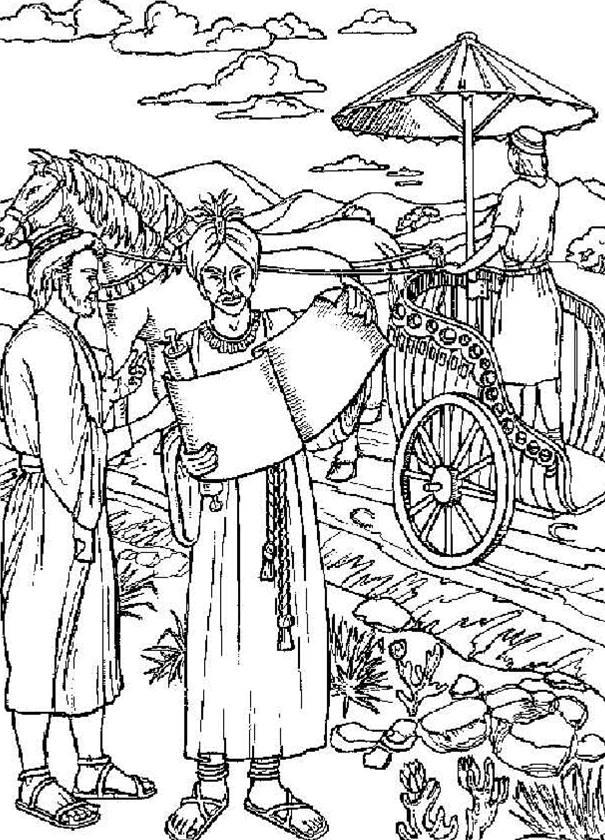
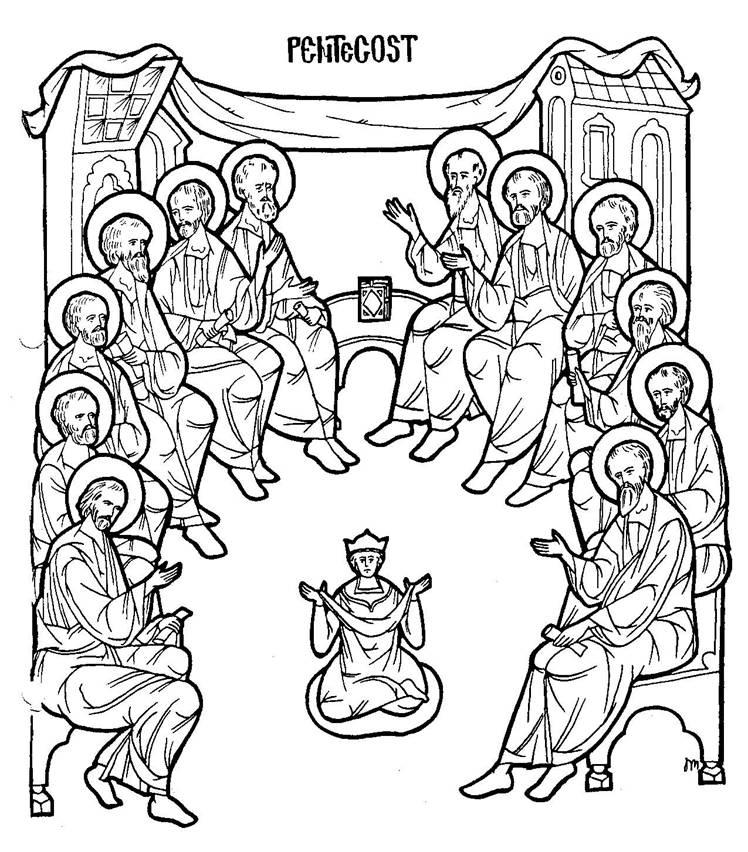
Philip and the Ethiopian
Stoning of Stephen
Stephen, the first martyr
The story of Stephen is in Acts 6 and 7. After the blessing of Pentecost, it is hard to face the reality of death.
Home Activities:
- Remind your child of older family members or friends who may have gone to be with the Lord; make koliva and celebrate a memorial service or visit the cemetery.
- As you go for a walk, look for stones; might be a good time to begin a rock collection, but discuss what the stones did to Stephen as well.
- With a small child, remember that he saw angels; sing “All night, All day”.
- With a school-age child, this might be a good week to watch TV or movies with your child, specifically looking for instances of anger and violence and comparing them with the anger of the Jews. What would he do in the same situation as the character? Look for situations where you could stand up for Christ as Stephen did.
All night, all day
Angels watchin' over me my Lord
All night, all day
Angels watchin' over me
Now I lay me down to sleep
Angels watchin' over me, my Lord
Pray the Lord my soul to keep
Angels watchin' over me
Prayer: Lord bless all our family and friends who are in heaven and protect all of us on earth with your holy angels.
What did Stephen say as he gave up his spirit?

![]()
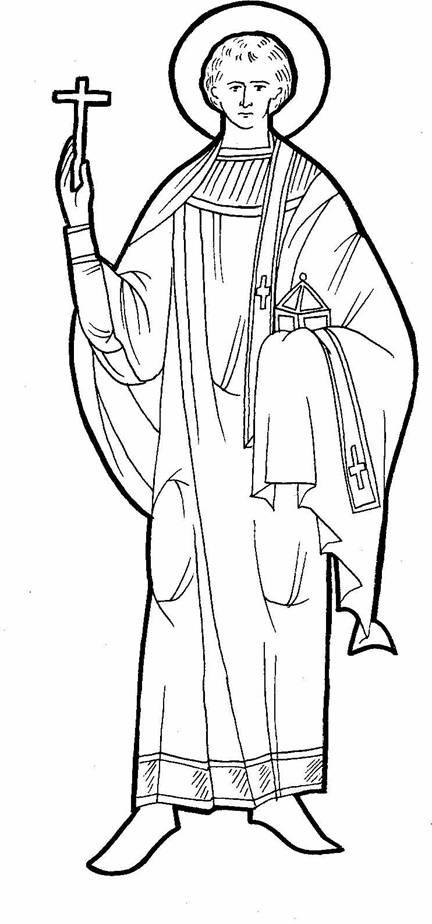
SAINT STEPHEN, THE FIRST MARTYR

THE STONING OF STEPHEN
Conversion of Saul
Conversion of Saul
This is a fun week! First read Acts 9.
Home Activities:
- Color the picture of Saul; do the maze puzzle.
- Go around the house blindfolded; play blind-man’s bluff.
- With older children, try learning to read Braille (It’s a lot harder than you think.) or navigate with a cane. Of course, after some experience with blindness, the child should appreciate sight all the more and be able to rejoice with Saul at the ministry of Ananias.
- If you’re more ambitious, or your child shows special interest, visit the Maryland School for the Blind or the American Federation for the Blind right here in Maryland for a tour.
- Finally, review in the Scriptures or Bible storybook the many instances where Jesus healed the blind, just as Saul was healed.
Prayer: Lord, let me see the way you want me to go, every day of my life.
CODED MESSAGE
Try using the Braille alphabet below to write a coded message. If you poke a pen point thru the dots, you can feel the letters as a blind person would. Can you write your own name?
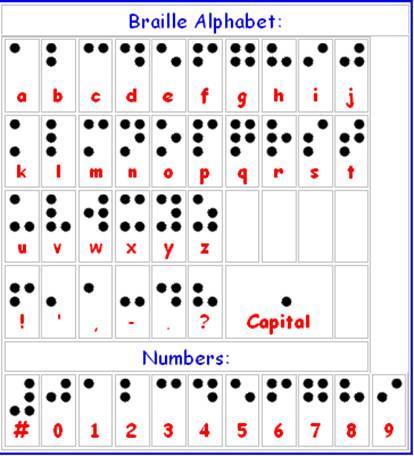
Can you write: Saul was struck blind on the road to Damascus and was healed by the prayers of Ananias.
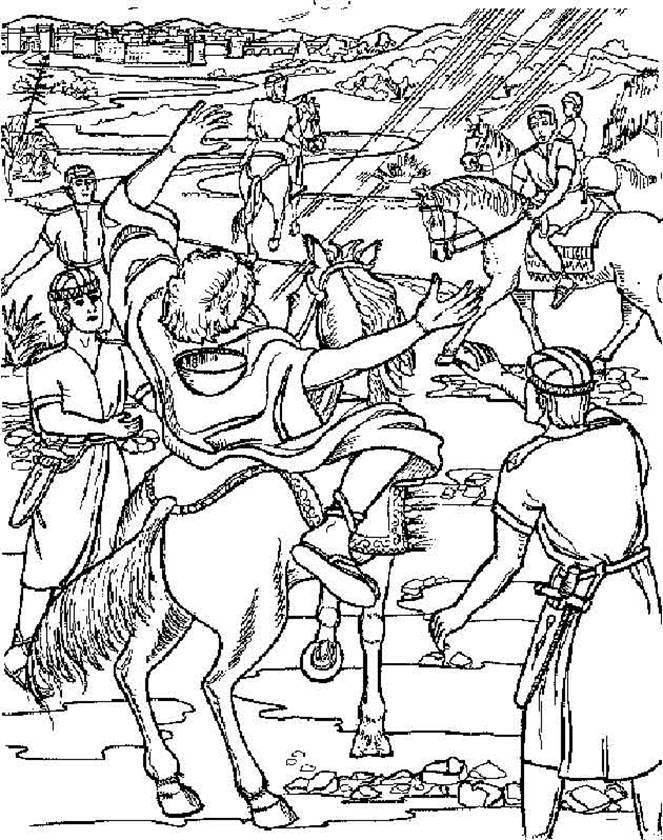
THE CONVERSION OF SAUL
PAUL’S VISION RESTORED BY ANANIAS
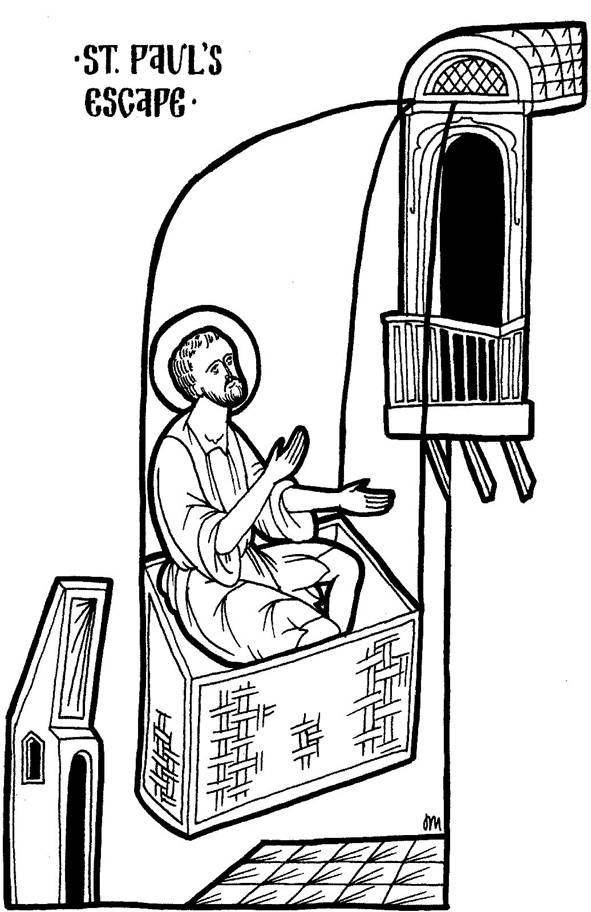
Peter and Cornelius
Peter and Cornelius
Another easy week. The story is found in Acts 10.
Home Activities:
- Gather up your stuffed animals, or go to the zoo. Read Leviticus 11; pick out the clean and unclean animals. Discuss the Jewish law.
- Or, try being kosher for a week; that will put any cook to a test!
- Visit an Orthodox Jewish synagogue; talk to some Jewish friends about being kosher. Now, your child will understand more fully how Peter felt, after living all his life in a totally Jewish society, when God asked him to preach to and baptize a Gentile.
- Sing “Jesus Loves the Little Children”:
Jesus loves the little children,
All the little children of the world.
Red and yellow, black and white,
They are precious in His sight.
Jesus loves the little children of the world.
Prayer: Lord, help me to love all your people just as You do.
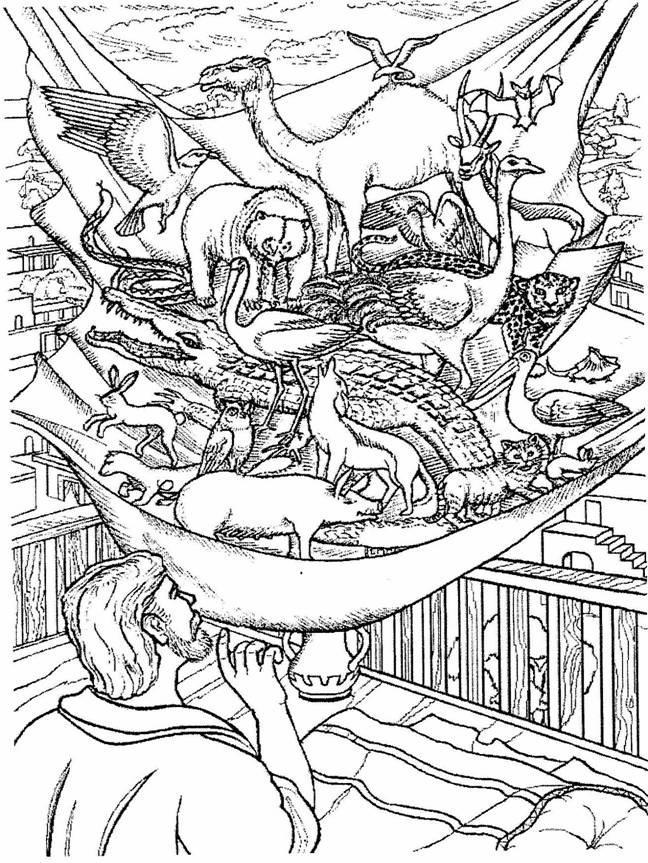
THE VISION OF ST. PETER
Council of Jerusalem
Council of Jerusalem
The first “business meeting” of the early church is found in Acts 15.
Home Activities:
- Role play the council with Peter, Paul, and James.
- Do you have a family decision to make this week? Have a family “council” and pattern it after the Jerusalem Council. Is everyone satisfied with the decision? Was Paul fully satisfied either? How do families and the church make decisions?
Prayer: Lord, guide us in every decision we make, just as You have guided your Church.
Council of Jerusalem Crossword
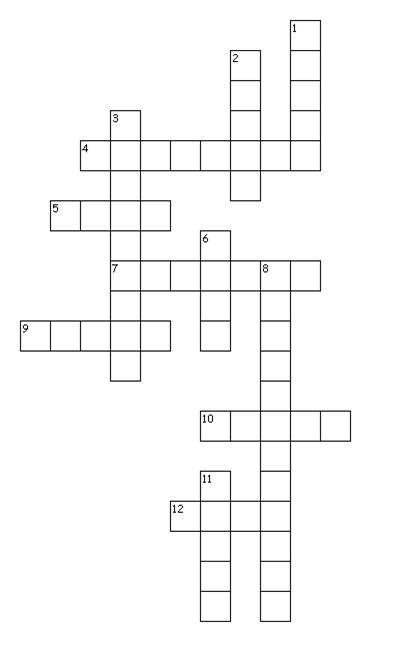
Across
4. people who are not Jews
5. the disciple to the Gentiles
7. where the decree was sent
9. his Law obeyed by Jews
10. bishop of Jerusalem
12. people who follow the Law
Down
1. Paul's companion who went to Antioch
2. abstain from gifts offered to them
3. where the council was held
6. symbol used by Christians
8. not required for Gentiles
11. one of the Twelve, who was present
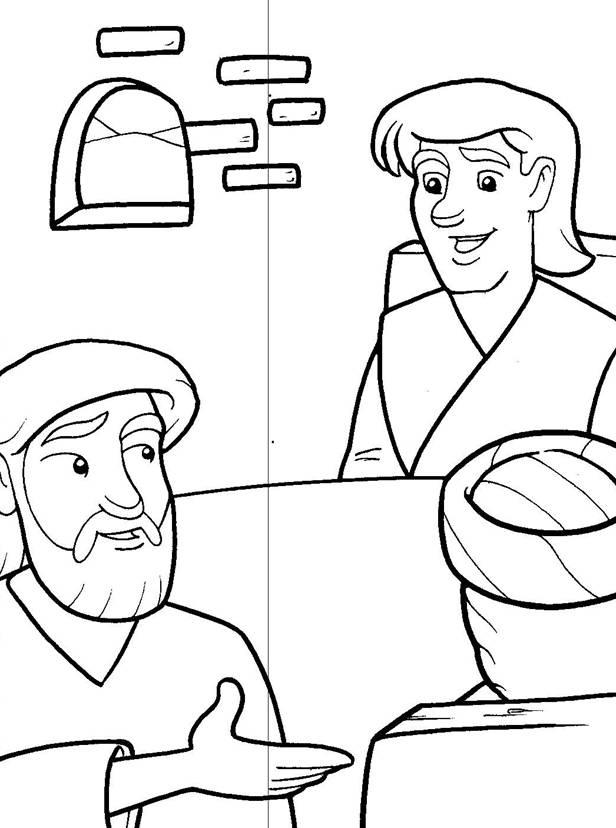
THE COUNCIL IN JERUSALEM
Spread of the Gospel
Spread of Gospel
This is probably the “busiest” week of the year.
Home Activities:
- Review the stories of one or two disciples each day. Where did they go? What did they do? There’s lots of drama here; the stories are exciting.
- Take a map of the world (or a globe) and mark all the countries the disciples reached.
- Get some books out of the library or search the Internet and look at pictures of these countries; what are they like today?
- Include Matthias; how was he chosen in Judas’s place? Can you make a decision this week by casting lots?
- Finally, what is evangelism? Color the picture of the 4 Evangelists. Have your child try telling a friend about Jesus at least once during the week and inviting a friend to church; is it easy?
Prayer: Lord, help me to spread Your Good News to all the world just as Your disciples did.
LIVES OF THE APOSTLES (IN BRIEF)
Where did they all go, these men who followed Jesus so closely? Let’s look quickly at their lives after the Ascension and Pentecost. Try to follow the trips on the map:
St. Andrew, the first-called, a fisherman by trade and brother of Peter, traveled to Scythia, Greece, Byzantium (later known as Constantinople), and finally to Russia. He is the patron saint of Russia and finally died on an X-shaped cross, preaching the whole time he was on the cross.
St. Thomas, better known as “Doubting Thomas” because of his doubts about the Resurrection, surely had no doubts after he saw Jesus with his own eyes. He traveled to far-off India to spread the good news of his faith and there, he died.
St. Bartholomew also is believed to have traveled to India and begin the Christian Church there. He then traveled to Armenia where he preached for many years. Finally, a wicked king named Astyages ordered Bartholomew killed.
St. Simon (the Zealot) left Palestine and traveled first to Egypt to preach about Jesus. St. Jude left Jerusalem after Pentecost and traveled to the land of Mesopotamia. In and around the city of Edessa he preached the good news of Jesus and the resurrection. Finally, he went to Persia with St. Simon and there in Persia both of these courageous apostles died for their faith.
St. James the Greater, son of Zebedee and brother of St. John the Beloved, traveled to Spain the preach; he is the patron saint of Spain to this day and is known there as Santiago (Our own San Diego is named for him.). He returned to Jerusalem to try to influence the Pharisees to accept Christ. But, the Jews still hated the Christians and begged King Herod Agrippa to put James to death. James was the first of the apostles to die and the second martyr (after Stephen).
St. Philip married and had three daughters who also became Christians. He traveled to Phrygia in Asia Minor. There he preached to the people of Hierapolis. These people worshipped a huge snake; Philip prayed and the snake died. Many of the people then believed in Jesus, but some were so angry they put Philip in prison. When Philip would not deny Jesus, he was crucified, head down, and went to heaven to be with his Lord.
St. Matthew remained for many years in the land of Israel, teaching the Jewish people about Jesus. He wrote the gospel of Matthew to tell the story of Jesus to his people. Finally, he traveled to Ethiopia to preach and was killed by those who hated Christians in that far-off land.
St. James the son of Alpheus, also known as James the Less and brother of St. Matthew, traveled after Pentecost first to the city of Eleutheropolis and then to Egypt. There he preached and performed miracles with great success and churches were founded. Finally he was killed in the town of Ostracina, being crucified by pagans.
St. Matthias was chosen by casting lots to take the place of Judas Iscariot, who betrayed Jesus. He had been one of the 70 men sent out by Jesus to preach and perform miracles. He was with the other 11 disciples at Pentecost and preached in the land of Judea. Then he traveled to the land of Cappadocia and began the church there. He also died for his faith.
St. John, the Evangelist, spent most of his ministry in the city of Ephesus. We will study him in more detail later.
There are 3 other very special apostles, even though they were not part of the first 12 chosen by Jesus. One of these was St. Mark, the Evangelist. Mark, or John Mark, was probably the young man who ran away naked when Jesus was arrested in the Garden of Gethsemane. Later, the first church in Jerusalem met at his home. He traveled with Paul and Barnabas on the first missionary voyage and left after part of the trip to go home to Jerusalem. Barnabas took Mark with him on later missionary trips to Cyprus and joined St. Paul in Rome. He also spent time with Peter in Rome and here he wrote down the gospel of Mark what Peter told him about the life of Jesus. After the deaths of Peter and Paul, Mark helped begin the church in Alexandria in Egypt. He became bishop of Alexandria and finally was martyred under the reign of the Roman emperor Nero.
St. Barnabas was actually named Joseph; the apostles changed his name to Barnabas, which means “Son of Encouragement”. We see glimpses of his work in the book of Acts. He was one of those who sold all he had in the early church in Jerusalem. Next we see him leading the newly converted Saul back to Jerusalem to meet the other Christians there. He was sent by the church in Jerusalem to Antioch, where believers were first called Christians. After a year in Antioch with Paul, the two set out on their first missionary journey. Barnabas also traveled with Paul to Jerusalem for the first church council. But, when Paul refused to trust John Mark to come on his next journey, Barnabas took Mark to Cyprus. They preached there together for many years until Barnabas was stoned to death in Salamis.
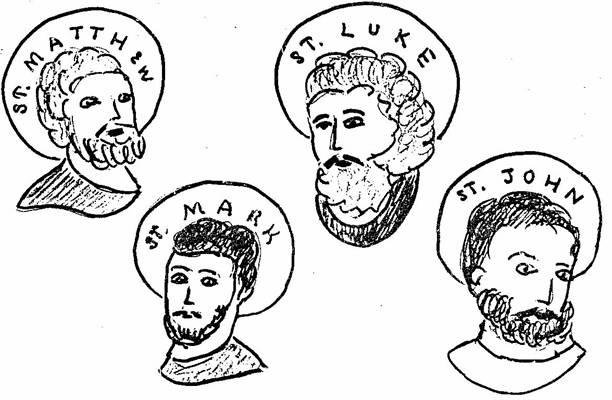
Finally, St. Luke, the Evangelist, was also an early companion of Paul. He was a Roman citizen and physician from the city of Antioch. He traveled with Paul through Asia Minor on his second missionary journey. He wrote down all they did and all he learned about the life of Jesus; we can still read these today in the Acts of the Apostles and the Gospel of Luke. He painted an icon of the Virgin Mary which he gave to the Theotokos herself; this is still a prized possession of the Patriarchate of Constantinople. Luke lived to be an old man and died in Thebes at the age of 84.
John and the Revelation
John/The Revelation
Home Activities:
- Review the life of St. John. Where was he at the calling of the fishermen? the Transfiguration? the Last Supper? the Crucifixion? Find him in the icons of these feasts.
- Color the picture of the lampstands and of the Archangel Michael.
- You can read parts of the Revelation; smaller children will be most interested in the word pictures in the Revelation of angels and thrones.
- Make paper angels.
- Watch a movie or TV show about angels.
- But, don’t forget the Last Judgment; look at the parables of Jesus about the sheep and the goats, those on His right and left hands, the Foolish Virgins, etc.
- Read C.S. Lewis’s “The Last Battle” out loud with older children.
Prayer: Lord, send my guardian angel to keep watch over me.
October 31 All Saints’ Party
After vespers in the Church Hall, dinner and party for costumed adults and children, dressed as saints. Choose your saint, possibly one we’ve studied or your name saint or another favorite. There will be games and fun for all. Only those in costumes are invited – that way no one will laugh.
The Churches of Asia from the Revelation
Across
2. Be faithful unto death
5. You allow that woman Jezebel
6. I have set before you an open door
Down
1. You have those who hold the doctrine of Balaam
2. You have a name that you are alive, but you are dead
3. You have left your first love.
4. You are neither cold or hot; you are lukewarm
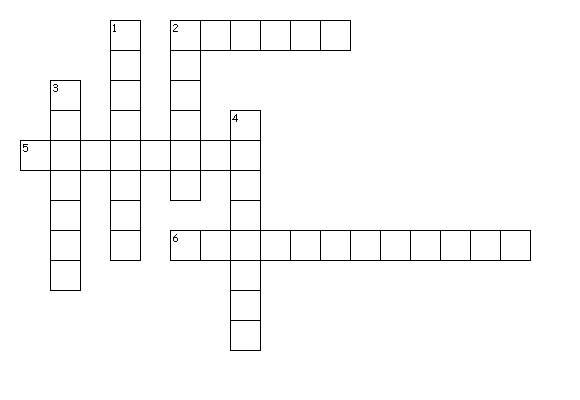
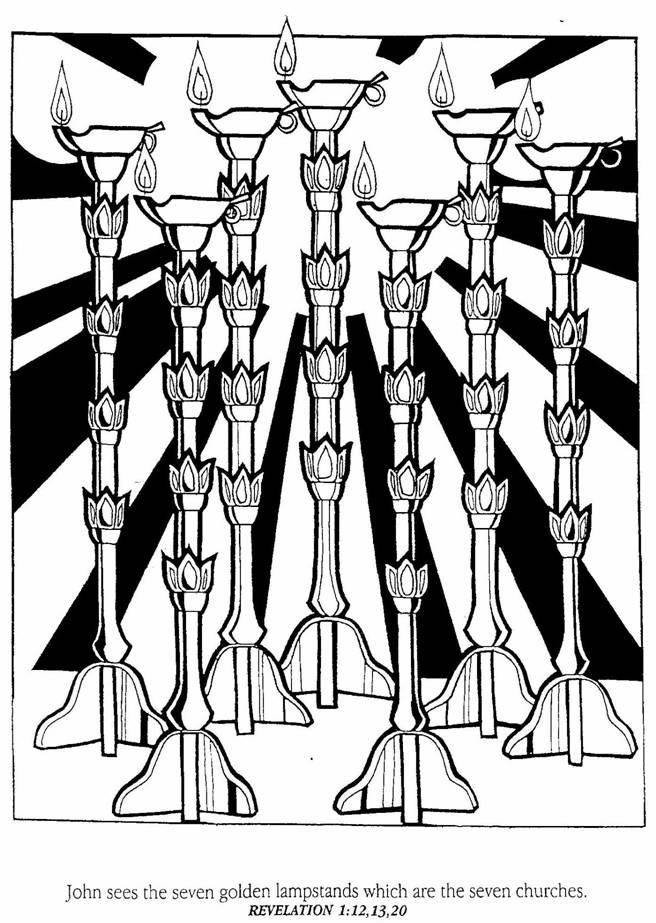
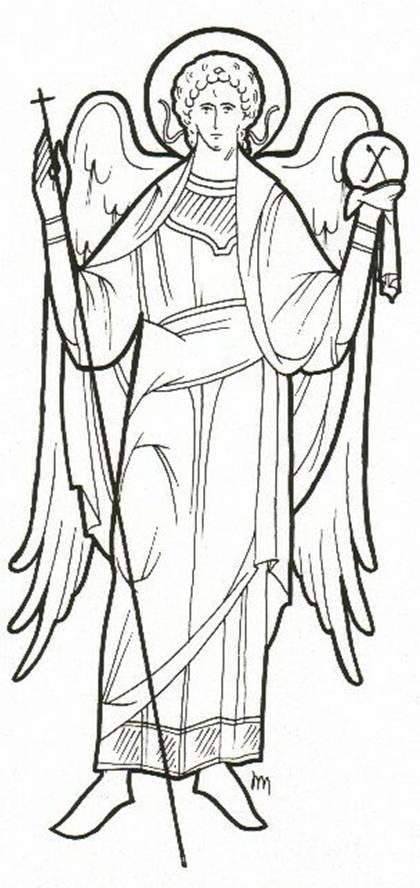
ST. MICHAEL, THE ARCHANGEL
Paul and his Journeys
Paul and Journeys
There’s a lot to cover on Paul, so he has 2 consecutive weeks. Paul’s journeys can be found in Acts 13-14, 16-28 – lots of reading.
Home Activities:
- Follow his journeys on your world map or globe.
- Do the puzzle.
- Make a small sailboat out of popsicle sticks and shipwreck it in a puddle or creek.
- Visit the snakes at the zoo.
- Again, get books from the library or research on the Internet Greece, Rome, and the areas of Asia Minor Paul traveled in and look at the cultures and geography of the lands involved.
- Talk about earthquakes and how to prepare for them.
- Paul was, by trade, a tentmaker; make a tent from a sheet and spend the night (pitch it in the house if it’s too cold to be outside).
- Paul spent years in jail; make cards for prisoners and gather toys for their children.
- Paul spoke about running a race for the Lord; go to the track and run some races or have a mini-meet in your yard for the neighborhood children (reminding them, of course, of the story of Paul).
Prayer: Lord, let me live my whole life, every minute, for You as did Paul.
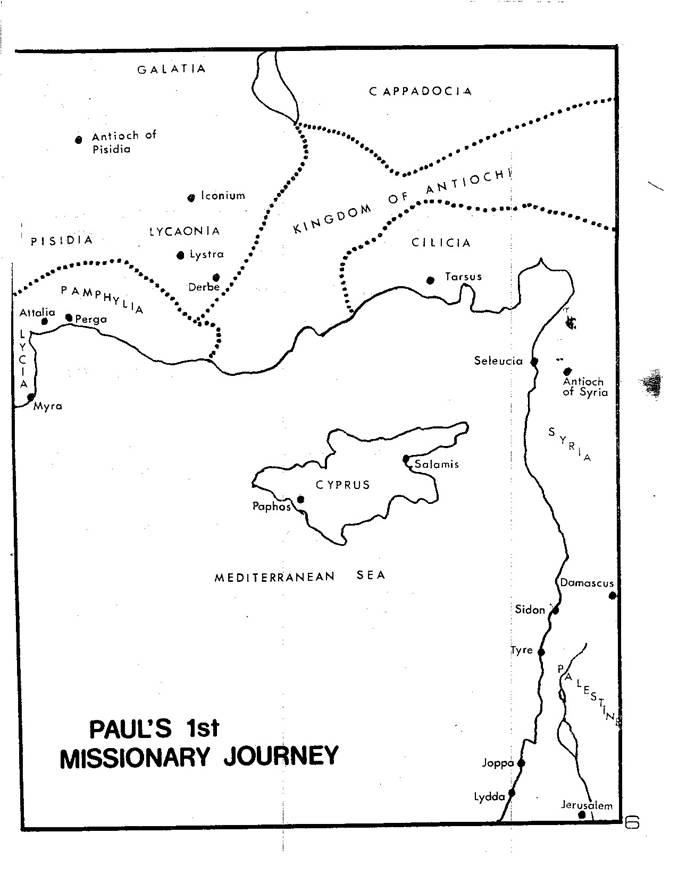
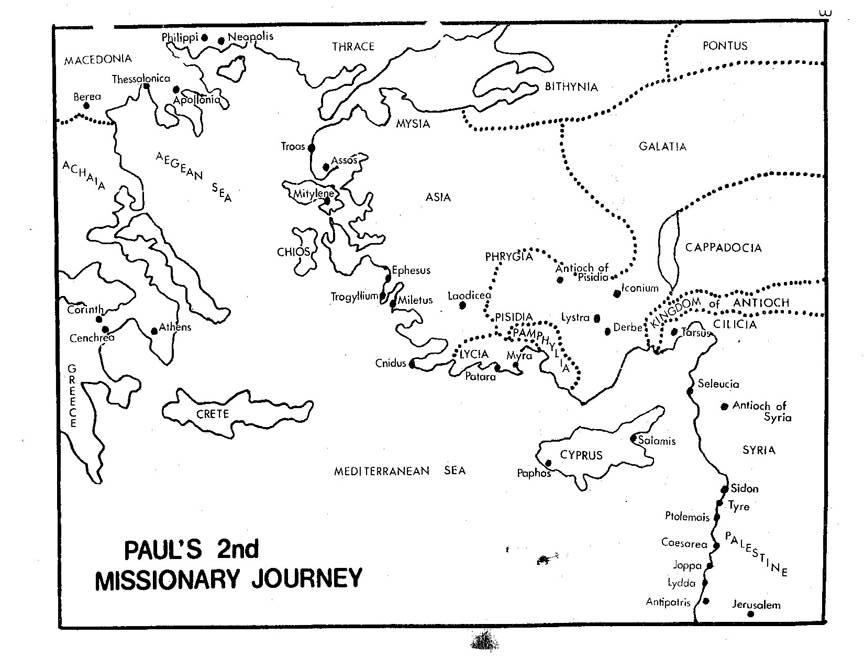
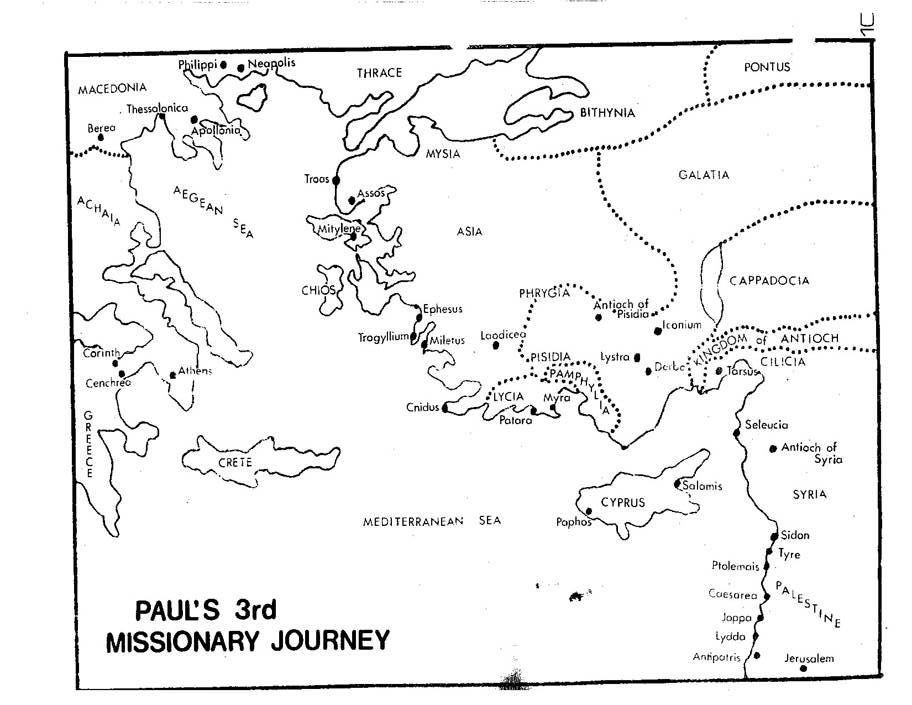
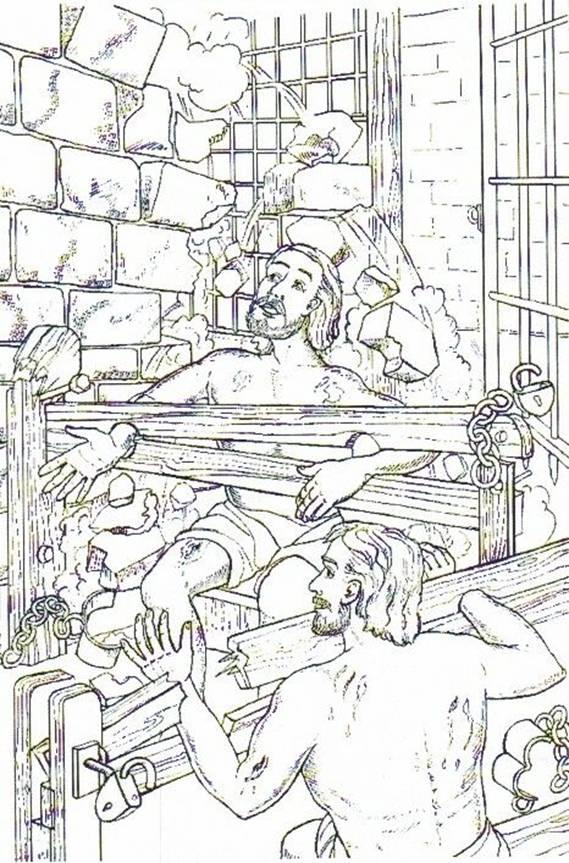
PAUL AND SILAS IN PHILIPPI
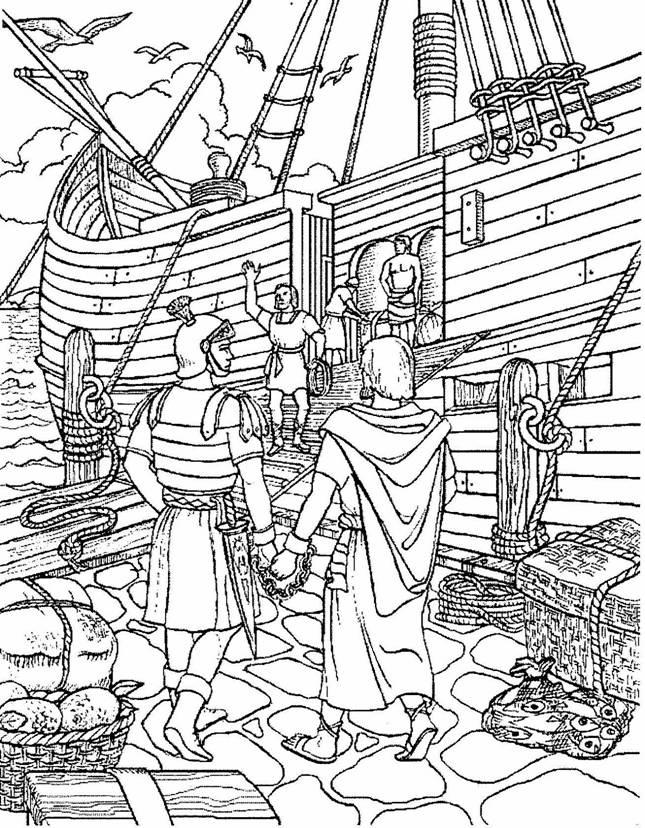
PAUL IN CHAINS GOING TO ROME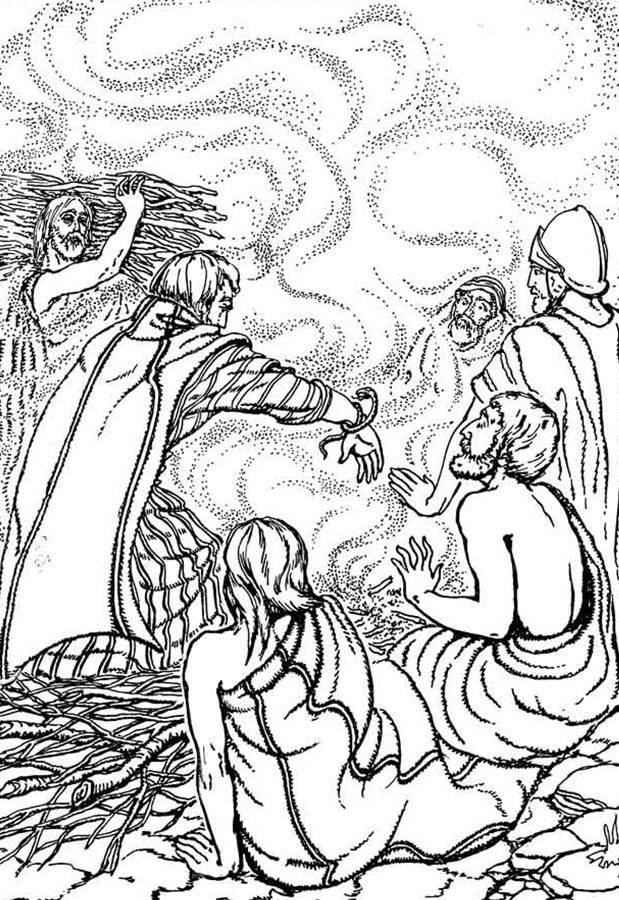
PAUL ON THE ISLAND OF MALTA
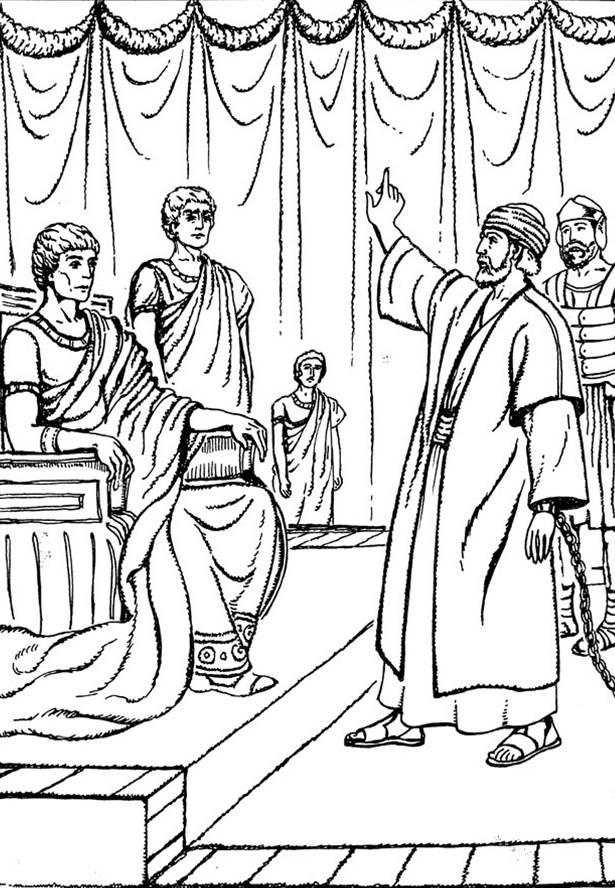
PAUL BEFORE THE EMPEROR IN ROME
Peter
Peter
Home Activities:
- We’ve already met Peter several times; review the stories of Pentecost, of Peter and Cornelius, and of the Council of Jerusalem.
- Color the picture of Peter and Paul; not only does each of these great saints have his own feast day, but they have yet another day together. Place the icon in your icon corner.
- Look through your Bible or storybook and reread the stories of last year when we studied the gospels – the calling of the fishermen (Matthew 4), the healing of Peter’s mother-in-law (Matthew 8), walking on water (Matthew 14), the Transfiguration (Matthew 17), the Last Supper (John 13), the denial (Matthew 26), the Resurrection (Luke 24). Lots of bedtime stories here; your child should know and love Peter by the end of the week.
- Look at pictures of bishops; Peter was the Bishop of Rome.
- Play with your keys; Peter was given the keys to the kingdom of heaven by Jesus Himself.
- Point out crosses and remind your child that Peter died on an upside-down cross.
- “Quo Vadis” would be a great movie to watch with the whole family.
Prayer: Lord, fill me with the same deep love for You that Peter had.
Advent does not actually figure in our curriculum this year. But, this is a wonderful opportunity to review the birth and life of Jesus. Make an advent calendar, decorating it with tiny icons or stickers. Review the entire Old Testament (studied 2 years ago) by decorating a Jesse tree with symbols of Old Testament characters.
How did Peter answer the lame man?
Dormition
Dormition
Home Activities:
- This is a major feast, so put the icon of the feast in your icon corner for the week.
- Color and mount a picture of the icon. Again, review who is pictured in the icon, what they are doing there, what is happening, etc.
- Pray again this week for members of the family who have passed away; make a list to give Father next time you bake Prosphora.
- Koliva is great, so make it again with your child.
Prayer: Most blessed Theotokos, pray for us.
The Dormition Double Puzzle
Unscramble each of the clue words.
Copy the letters in the numbered cells to other cells with the same number.
Mother of Mary
Father of Mary
Where Mary grew up
The "Announcement"
The angel who announced
Mary's husband
Where Mary lived later
Where Mary was buried
Disciple who was not there
Jew who tried to topple bier
What Thomas smelled
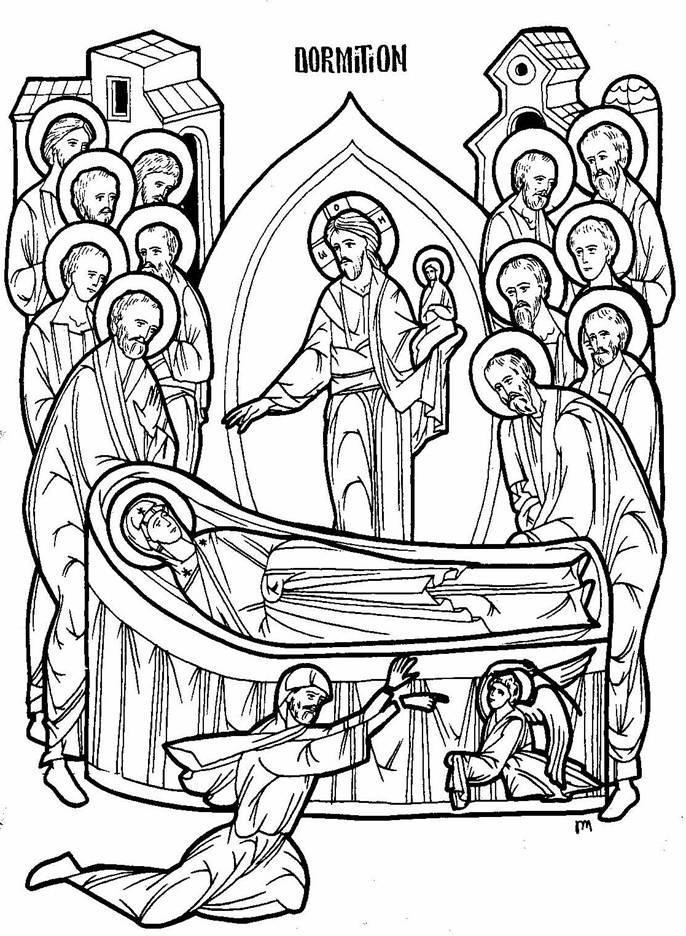
Persecutions
Persecutions
This week we are focusing on the martyrs, especially in the days of the Romans.
Home Activities:
- Many of your children will have the saint’s name of a martyr and you can review the life and death of these saints.
- Any book on the lives of the saints will have multiple choices for bedtime stories; focus on the courage of the saint and not so much on the gory details.
- Watch “The Robe” together as a family, complete with popcorn.
- For older children, remind them that Christians are still being persecuted around the world; point out some of the countries on the world map or globe.
Prayer: Lord, give me the trust and courage that you gave the martyrs.
Do you know the song to the martyrs sung at each wedding?
Rearrange the tiles to see the prayer.

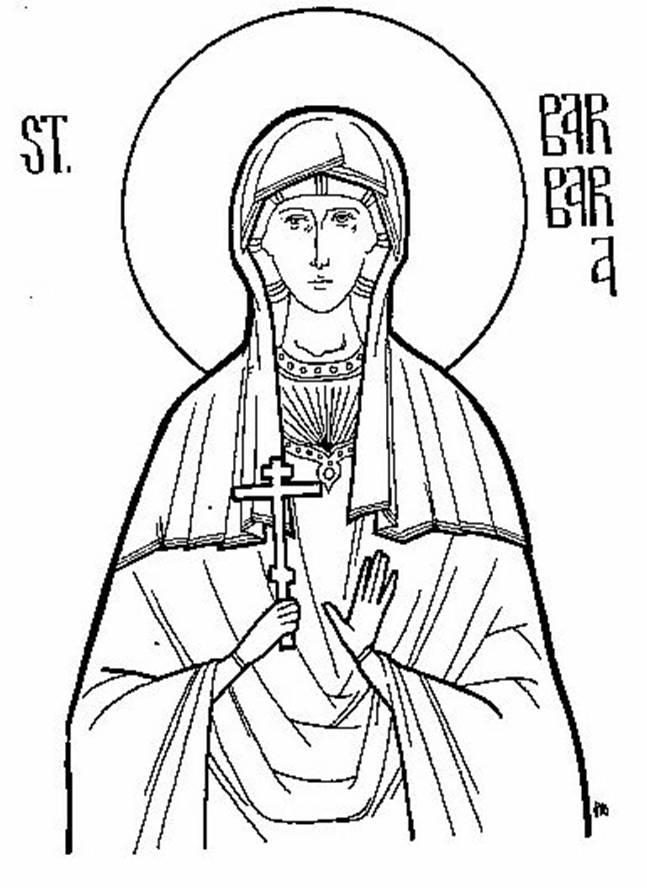
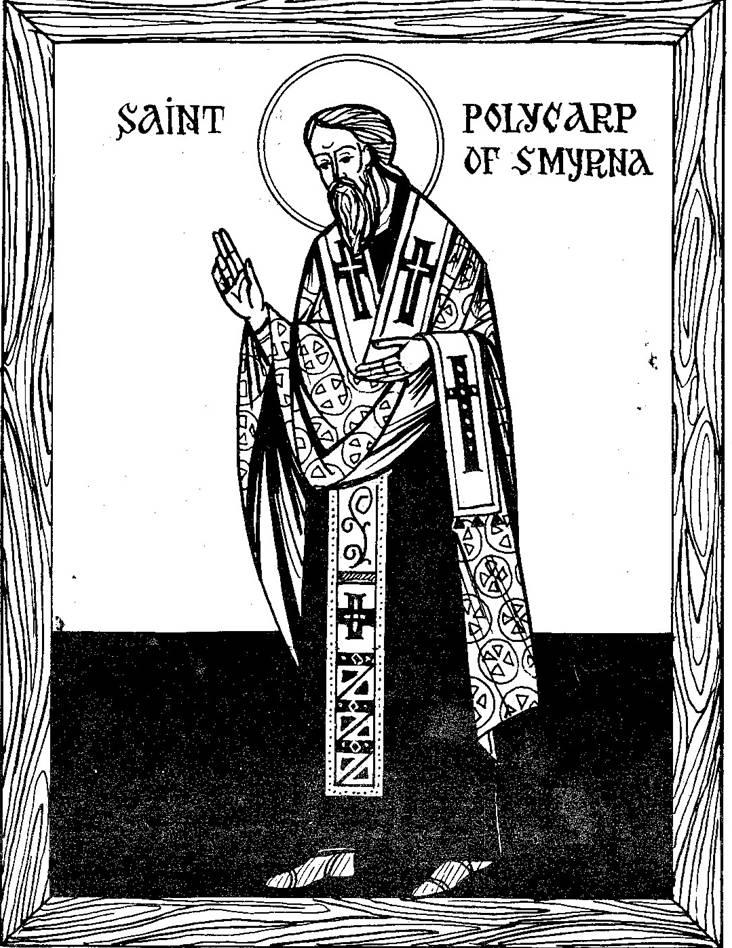
St. Nicholas
St. Nicholas
This lesson should be scheduled to occur right before St. Nicholas Day, December 6. St. Nicholas will visit during opening exercises on Sunday. During coffee hour we will perform our St. Nicholas play for the congregation and for Ridgeway Manor Nursing Home. Look for a script to come home in November with costume suggestions in November.
Home Activities:
- On the evening of December 5, put your child’s shoes outside your door with much pomp and circumstance.
- Review at bedtime the story of St. Nicholas and color his icon.
- Solve the puzzle below for the words to the song of St. Nicholas; sing it frequently.
- While your child sleeps, fill the shoes with chocolate coins, nuts, candy, fruit, or other goodies. In the morning…
- This is the beginning of Christmas! Sing the St. Nicholas song through the week. Begin to bake cookies, decorate, make gifts, etc.
- Remind your child that St. Nicholas gave gifts to others and plan to make gifts or favors for a neighborhood nursing home, children’s home, day-care, etc.
- Advent is already in progress. You can use our printed Advent Calendar, coloring one star for each day. You can fill in the days before St. Nicholas Day.
Prayer: Lord, bless all the children of the world, through the prayers of our holy father, Nicholas.
 Do you know the song to St. Nicholas?
Do you know the song to St. Nicholas?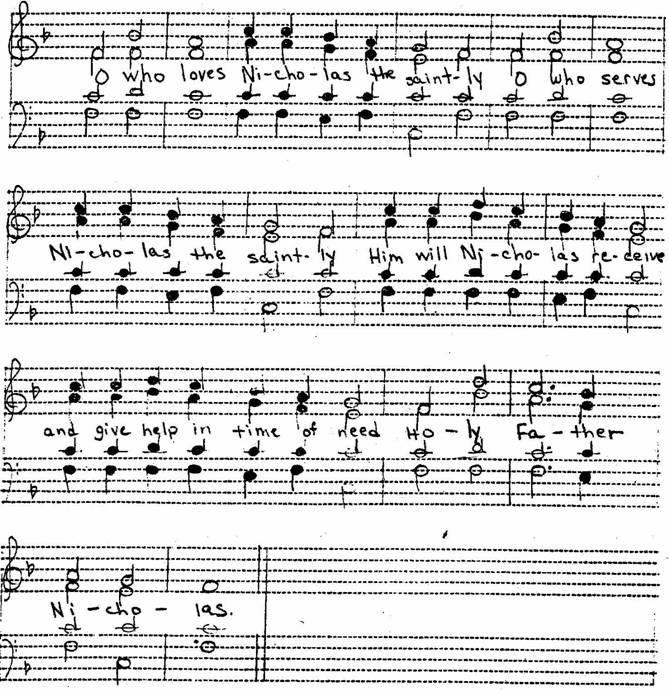
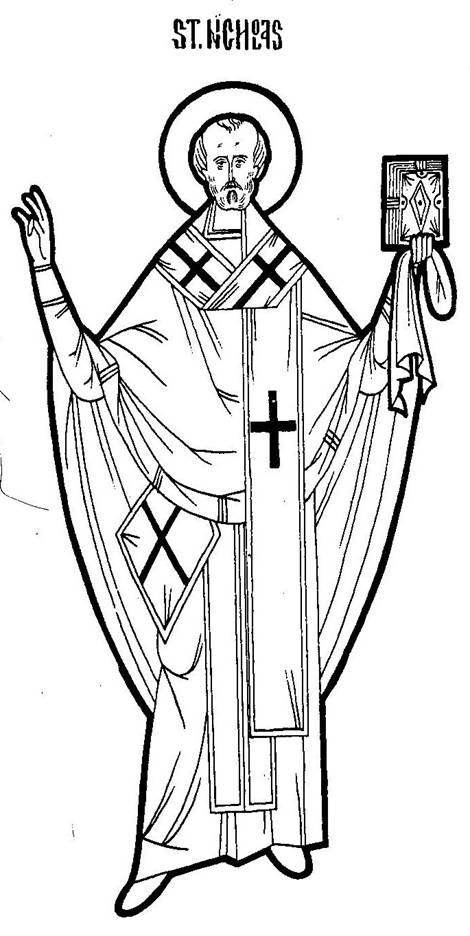
Constantine
Constantine
Home Activities:
- Constantine is considered Equal to the Apostles; why?
- Discuss dreams and visions with your child; who else in the Bible had visions that changed the course of history? Read the stories of Noah, Joseph, Moses, Samuel, Zachariah, etc.
- Make shields decorated with crosses and outfit the neighbors, marching them up and down to “When the saints go marching in”.
- Color the icons of Constantine and Helen and of the Holy Cross they served.
Prayer: Lord, help me to trust You and obey You as did your servant Constantine.
Elevation of the Cross
Elevation of the Cross
Home Activities:
- Review the story of the finding of the cross with your child.
- In your Bible storybook, reread the stories of the healing miracles of Jesus; how did St. Helen identify the true cross?
- Look for crosses – they’re everywhere!
- Also, reread the story of the Crucifixion. As you drive, as you shop…
-
It’s winter now, but a good time to plant herbs. Plant some basil for the feast NEXT YEAR! Use any pot and color and glue on the special “pot cover”. Fill with dirt, plant seeds, and put it in the sun, watering regularly. You can plant it outside in the spring or just keep it in a larger pot.
- Wear a cross every day – might even buy a new one for the week to make it more exciting for your child to wear.
- Review with your child how to cross himself “correctly” and do it regularly.
Prayer: Lord, bless all Your people through the saving power of Your holy Cross. “Before Thy Cross, we bow down and worship, O Master, and Thy holy Resurrection we glorify!” (Sing it three times, prostrating each time; children love prostrations!)
ELEVATION OF THE CROSS CRYPTOGRAM
Can you find the words we say in church several times a year? We’re using Greek letters for the code to celebrate the moving of the Roman capital towards the east in Constantinople.

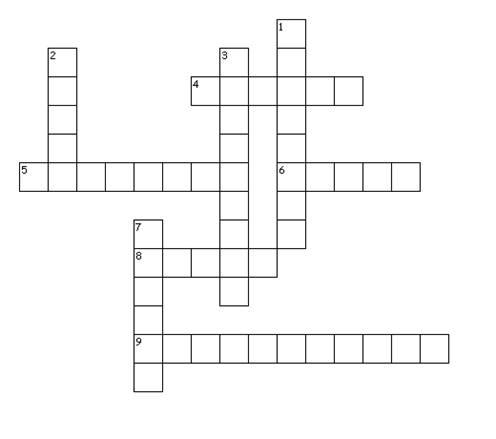
Elevation of the Cross Crossword
Across
4. What happened to the sick woman
5. Bishop of Jerusalem
6. Number of crosses found
8. Mother of the Emperor
9. the Emperor
Down
1. Hill where Jesus was crucified
2. City where her ship landed
3. City where Jesus was crucified
7. Built on site where the cross was found
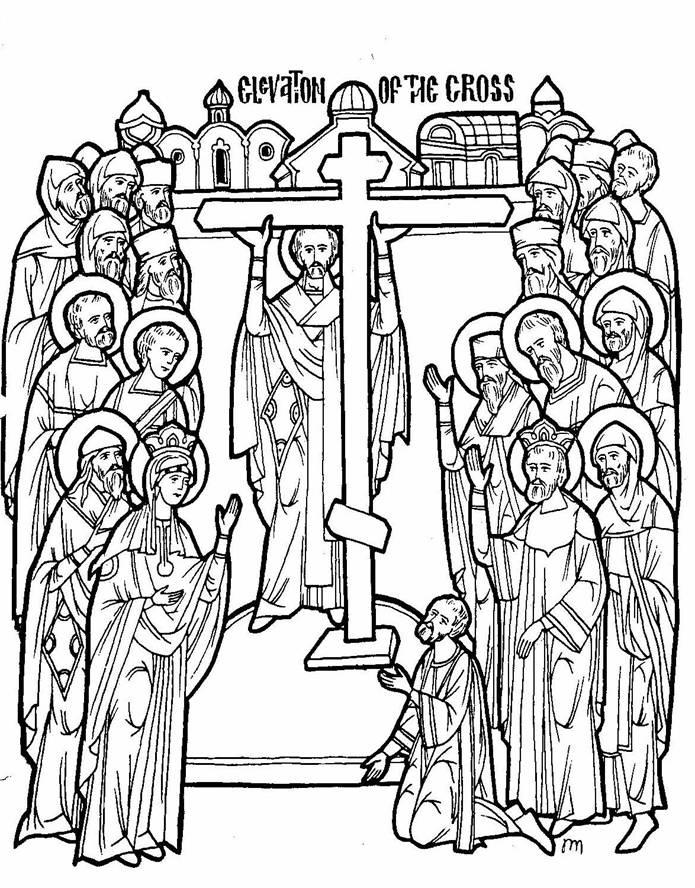
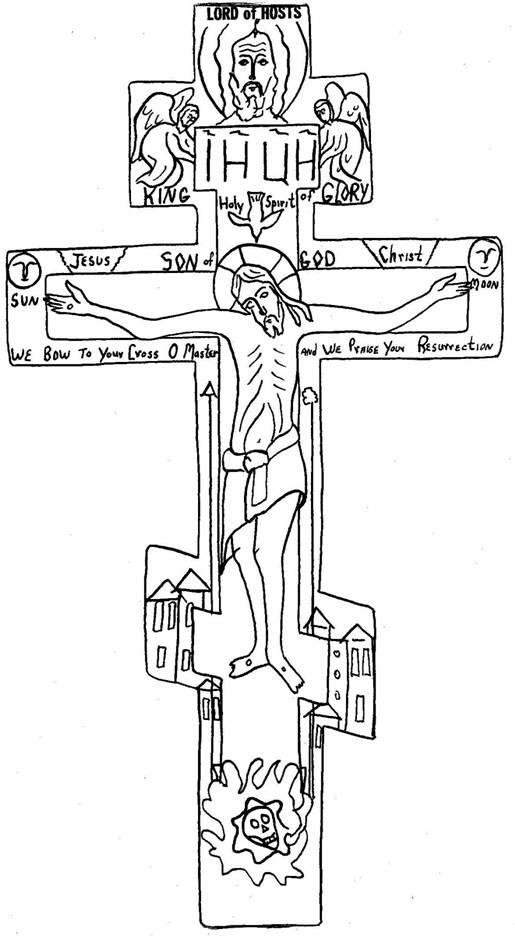
Mary of Egypt
St. Mary of Egypt
Home Activities:
- Mary lived a life of fasting and prayer. Try a day of total silence, or a day of bread and water only (No, your child will not starve to death!), or to pray for even one hour without stopping.
- Or, if your child is intrigued and motivated, try a hermit day – all alone in a room with only a Bible and water and bread, in total silence except for prayer – the ultimate “time out”.
- Look at pictures of deserts in National Geographic or library books; think about the heat and dryness.
- While your child is “enjoying” hermit-day, visit him or her briefly as Fr. Zossima did, possibly bring a bit of honey for the bread and an icon picture for him to color.
Prayer: Lord, help me to pray each day with your beloved saint, Mary of Egypt.
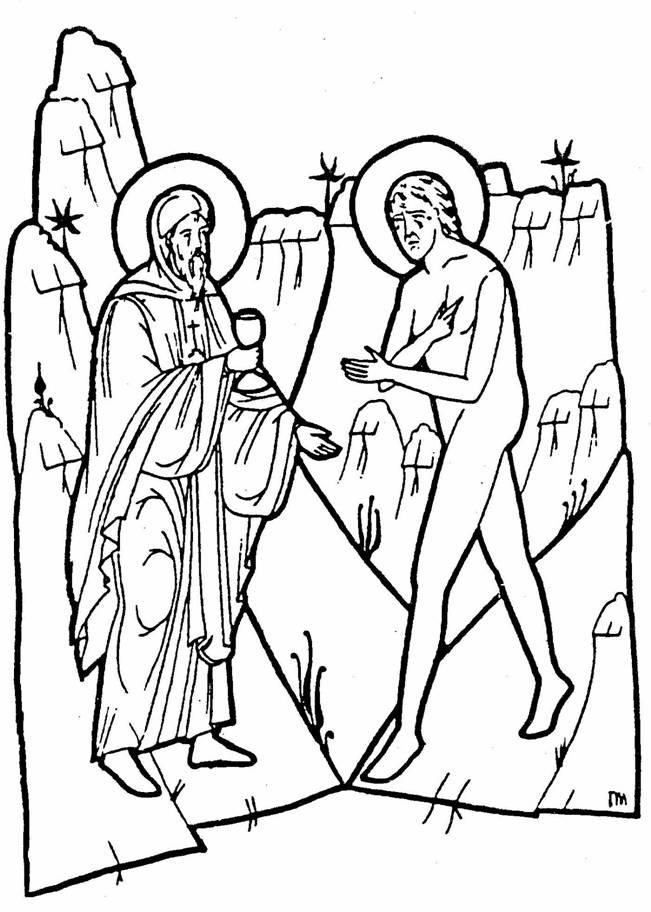
ST. MARY OF EGYPT
Canon of Scripture
Canon of Scripture
Memory work begins this week. The smallest children should learn the names of the four gospels and Acts. The 6-9 year olds should learn all the books of the New Testament. And the 10-12 year olds should learn all the books of the Bible. The treasure chest will provide a prize during opening exercises next week for all who can recite. Work on the memory work in the car, at home, etc. Note that the Orthodox Study Bible books are a bit different from those of the Protestant Bible AND the Roman Catholic Bible. The bookmark can be printed on cardstock and used for memorization. You can use the handy song to memorize the books of the Old Testament; those of the New Testament are the same in all of the Bibles.
BOOKS OF THE OLD TESTAMENT
(to the tune of the verses of “Jesus Loves Me”)
Genesis, Exodus, Leviticus,
Numbers, Deuteronomy,
Joshua, Judges, Ruth God brings,
Kingdoms 1,2,3, and 4,
Two of Chronicles and Ezras two,
Nehemiah,Tobit, Judith
Esther, Maccabees all three,
Psalms, Job, Proverbs, Ecclesiastes,
Song of Songs and Wisdoms two
Hosea, Amos, Micah, Joel,
Obadiah, Jonah, not all,
Nahum, then comes Habakkuk,
Zephaniah, Haggai,
Zechariah, Malachi
Isaiah, Jeremiah
Baruch and Lamentations, too.
Jeremiah’s Epistle then.
Ezekiel, Daniel, that’s the end,
All of these God’s works foretold
And His promises of old.
BOOKS OF THE NEW TESTAMENT
(to the tune of the ABCs)
Matthew, Mark and Luke and John,
Acts and Romans, Corinthians 2
Galatians, Ephesians, Philippians, Colossians,
1st and 2nd Thessalonians,
1st and 2nd Timothy,
Titus, Philemon, Hebrews, James,
2 of Peter and 3 of John,
Jude and the Revelation.
Now we know the 27 books
Of the New Testament of Christ our Lord.
Prayer: Lord, thank you for giving us your Bible.
The Canon of Scripture Word Search
Athanasius and the Creed
Athanasius/Creed
Memory work continues. The smallest children should learn the first line or two of the creed; everyone else should be able to say (or sing) the entire creed. After all, we hear it every week in church! Again, work on it bit by bit through the week and a prize will be given on Sunday. But don’t forget St. Athanasius; read his story and color his icon.
Prayer: Lord, may all Christians be one in the true faith you revealed to St. Athanasius and the council with your Nicene creed.
CREED MATCHING
Match the first half of each verse to the second, beginning with:
I BELIEVE
In one God begotten of the Father before all ages.
Maker of heaven and earth came down from heaven,
And in one Lord Jesus Christ, and sitteth at the right hand of the Father ,
The only begotten, and suffered and was buried,
Light of Light, Who proceeds from the Father,
Begotten not made, the Son of God,
Who for us men and for our salvation and apostolic church.
And was incarnate of the Holy Spirit and to judge the living and the dead, Whose
the Virgin Mary Kingdom shall have no end.
And He was crucified for us under Pontius Pilate the Father Almighty,
And the third day He rose again is worshipped and glorified, Who spoke
by the prophets.
And ascended into heaven of one essence with the Father by Whom all
things were made.
And He shall come again in glory and became man.
And in the Holy Spirit, the Lord, the giver of Life and of all things visible and invisible.
Who with the Father and the Son together for the remission of sins.
And in one holy catholic according to the Scriptures.
I acknowledge one baptism and the life in the world to come.
I look for the resurrection of the dead true God of true God,
AMEN
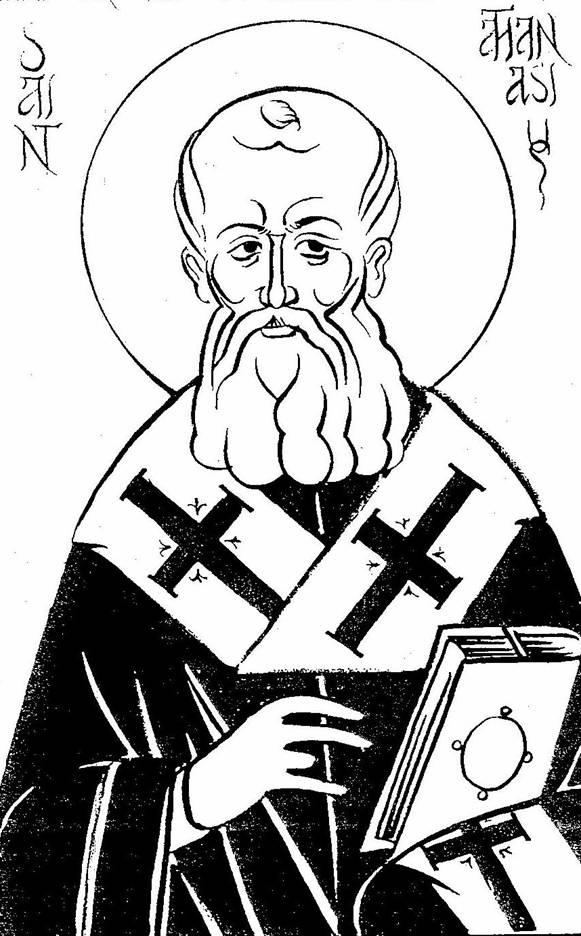
John Chrysostom and the Liturgy
Chrysostom/Liturgy
Home Activities:
- As you stand through liturgy this week, point out what’s going on to your child.
- When we get to the creed, sing it with your child.
- If you didn’t quite get all the memory work completed for the past two weeks, work on it again; we’ll give the children another chance next Sunday to recite their books of the Bible or Creed.
- Retell the story of St. John Chrysostom and the lion;
- Visit the lions at the zoo.
Prayer: Lord, thank you for giving us your liturgy through the golden-tongued St. John Chrysostom.
Can you identify these liturgical items?
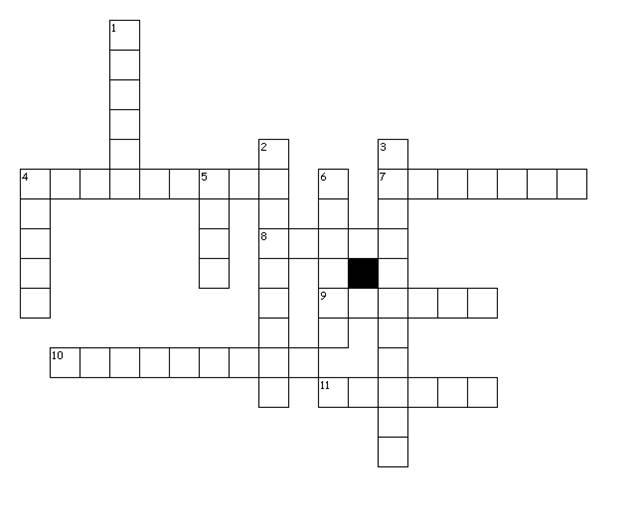
Across
4. Covers the communion bread
7. Communion cup
8. Used to receive Communion
9. Books of Matthew, Mark, Luke, John
10. Worship place
11. Plate for the bread
Down
1. To burn incense
2. Bread to be blessed
3. Icon screen
4. Knife for the bread
5. Covers chalice and paten
6. To clean the cup
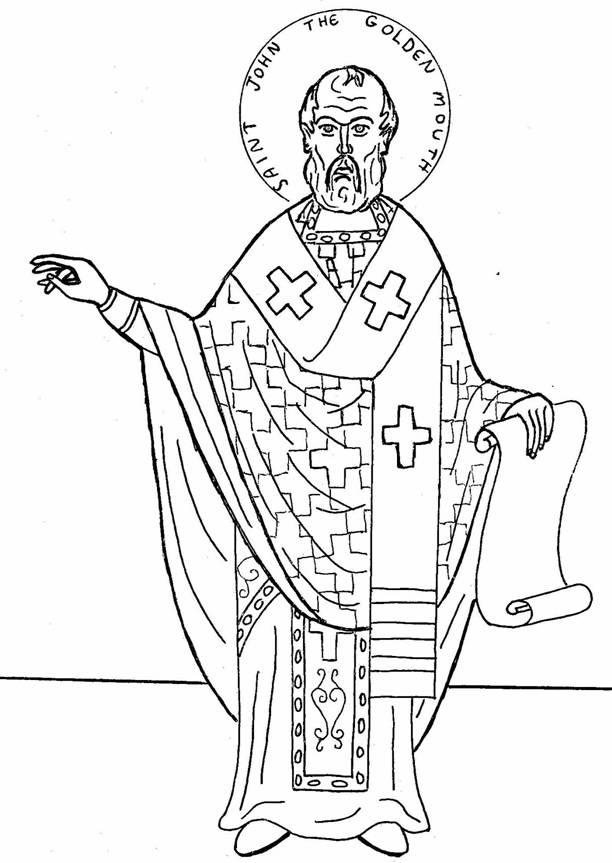
Three Hierarchs
Three Hierarchs and the Cappodocian Fathers
Home Activities:
- St. Basil, with his far-reaching ministry, is the best-known of this group. Visit a hospital; Basil founded hospitals.
- Visit a homeless shelter; Basil sheltered travelers and homeless people in his day.
- With an older child, read through the Liturgy of St. Basil, next to the Liturgy of St. John Chrysostom, in the worship notebooks; how are they alike and how different?
- Vasilopita, or St. Basil's bread/cake, is well known. Make it with your child and hide a coin in it. Why?
- Or, make St. Basil's Jewel Jello Cake.
- Color the icon picture of all three together for your icon corner.
Prayer: Lord, help me to serve You and Your people as did Your servants Basil, John, Gregory, and Gregory.
A Simple Recipe for Vasilopita
Ingredients
- 1 cup (2 sticks) unsalted butter
- 1 cup sugar
- 3 extra-large eggs
- Grated rind of 2 large oranges
- 1 teaspoon cinnamon
- 4 cups flour
- 2 teaspoons baking powder
- 1/2 teaspoon salt
- 1/2 cup milk
- 1 egg yolk blended with 1 tablespoon milk
- sesame seeds
- blanched almonds
- a clean coin - a quarter will do nicely - wrapped in silver or gold foil
Preparation
1. Preheat the oven to 350 degrees. Thickly butter a 10-inch round spring form pan.
2. In a large bowl of an electric mixer, cream the butter until it is light and fluffy. Beat in the sugar and beat until the mixture is light. Beat in the eggs, one a time, beating well after each addition. Beat in the orange rind and cinnamon.
3. In a separate bowl, sift together three cups of the flour, the baking powder and salt.
4. With the mixer on low speed, gradually beat in the dry mixture alternately with the milk. The batter will be very thick. Using a wooden spoon, gradually blend in the remaining flour, beating well until completely smooth.
5. Spread the batter into the pan, press the coin into the dough until it is completely covered (don't let anyone see where you place it!), and then smooth the top. Brush the top evenly with the egg and milk mixture and sprinkle with sesame seeds. Gently press the blanched almonds into the top to make a Cross and spell out the date of the new year.
6. Bake for 45 minutes, until golden brown (if it browns too quickly, cover the top with aluminum foil). Cool in the pan for 15 minutes before removing from spring form and thoroughly cool before slicing.
St. Basil’s Jewel Cake Recipe:
St. Basil’s feast day is on January 1 and another tradition is to make a “St. Basil’s Cake” on New Year’s to celebrate one of his miracles! St. Basil was a Bishop, and a friend of the poor. He wanted to help the poor people pay their taxes, so he went around town collecting jewelry from each person. He took it all to the governor, but the governor took pity on the people and told them to keep their jewelry. There was just one problem- St. Basil didn’t know which piece of jewelry belonged to who! So, he baked cakes with the jewels and gold inside, and distributed them to the people. That’s when the miracle happened- each person got exactly the piece of jewelry back that they had given! So, make a cake with jewels inside and tell this story of St. Basil.
Ingredients:
- 4 packages of Jell-O (3 oz each) in different colors
- 1 can of sweetened condensed milk
- 2 envelopes of unflavored (Knox) gelatin
- With each package of Jell-O, mix with 1 cup of hot water, stir until it dissolves, and put it in the fridge. You’ll need 4 separate containers for the 4 different colors. Let this chill until it is firm. Note this is different from the directions on the packages.
- To make your white filling, add both of your Knox gelatin packets to 2 cups of hot water and stir until it dissolves. Stir in your can of sweetened condensed milk, and then let this sit and come to room temperature.
- While you’re waiting, prepare your Jell-o “jewels;” take all of your Jell-o, cut it into squares, and pour the squares into your pan.
- Once you have all of your jewels in place, pour the white filling over them.
- Place your dish in the fridge, and allow this to set up. It will take at least 3 hours. Remove from pan to serving plate OR fix in a clear pan to start with.
- Ice with whipped cream or cool whip.
When you’re all finished, your cake will be hiding the jewels inside!
CAN YOU IDENTIFY ME?
HINT: I am either Basil the Great, Gregory Nazianzus, or Gregory of Nyssa – one of the Cappodocian Fathers.
I wrote a Liturgy still used today. I am _____________________
I am known as “The Theologian.” I am _____________________
I am Basil’s brother. I am _____________________
I am Basil’s good friend. I am _____________________
I am known for organizing monastic life. I am _____________________
I was bishop of Nyssa. I am _____________________
I was bishop of Caesarea. I am _____________________
I was bishop of Sasima. I am _____________________
I was married to Theosebeia. I am _____________________
God protected me in an earthquake. I am _____________________
God saved me from a storm at sea. I am _____________________
I gave bread with coins to the poor. I am _____________________

Ecumenical Councils/St. Cyril of Alexandria
Ecumenical Councils/St. Cyril of Alexandria
The smaller children will focus on St. Cyril of Alexandria, while the older students study the councils.
Home Activities:
- Review St. Cyril, even with your older student.
- St. Cyril taught us about the role and place of the Theotokos. Put an icon of Mary in your icon corner.
- Retell the story of the Annunciation and the Nativity. Retell the story of the Crucifixion (John 19), Resurrection (Luke 24), Ascension (Acts 1), Pentecost (Acts 2), and the Dormition. Point out Mary in the icons of these feasts; what is she doing there?
- Review St. Athanasius and St. Nicholas. Which council did they attend?
Prayer: Lord, we honor your mother, Mary the Theotokos, as we are taught by Your servant St. Cyril of Alexandria.
COUNCIL CONFUSION
While it may seem an impossible task to keep the councils straight, the councils ARE the backbone of Orthodox theology and are worth the effort for the older student. While the younger ones are coloring the icons, let’s work on the first 6 councils (after the Council of Jerusalem, which is not numbered):
1. Where was I held? CANIE ________________________
Who called me? TOCNASENTNI ________________________
Whose heresy was condemned? SAIRU ________________________
Who defended the faith? STANAHUASI ________________________
What was the result? DEREC ________________________
2. Where was I held? PLONECNATNISTO ________________________
Who called me? STEDSHOOIO ________________________
Whose heresy was condemned? SCUDNIAMOE ________________________
Who defended the faith? ODOSTOSHIE ________________________
What was the result? DRECE ________________________
3 Where was I held? SHEPSUE ________________________
Who called me? SHOOTEDSIO2 ________________________
Whose heresy was condemned? SRETSNOIU ________________________
Who defended the faith? RICLY ________________________
What was the result? STOOTHEKO ________________________
4. Where was I held? CLODNEHAC ________________________
Who called me? CRANIMA ________________________
What heresy was condemned STIMOONHIMSPY ________________________
Who defended the faith? OLE ________________________
What was the result? LANNICLIEDCH DEREC ____________________
5. Where was I held? SPOCLATETONNIN _______________________
Who called me? SNITUNIJAS ________________________
What heresy was condemned? STIMOMIPOSHNY ________________________
6. Where was I held? NOTNIPSOCANTEL ________________________
Who called me? SLICHUREA ________________________
What heresy was condemned? SLITOOMETHIMN ________________________
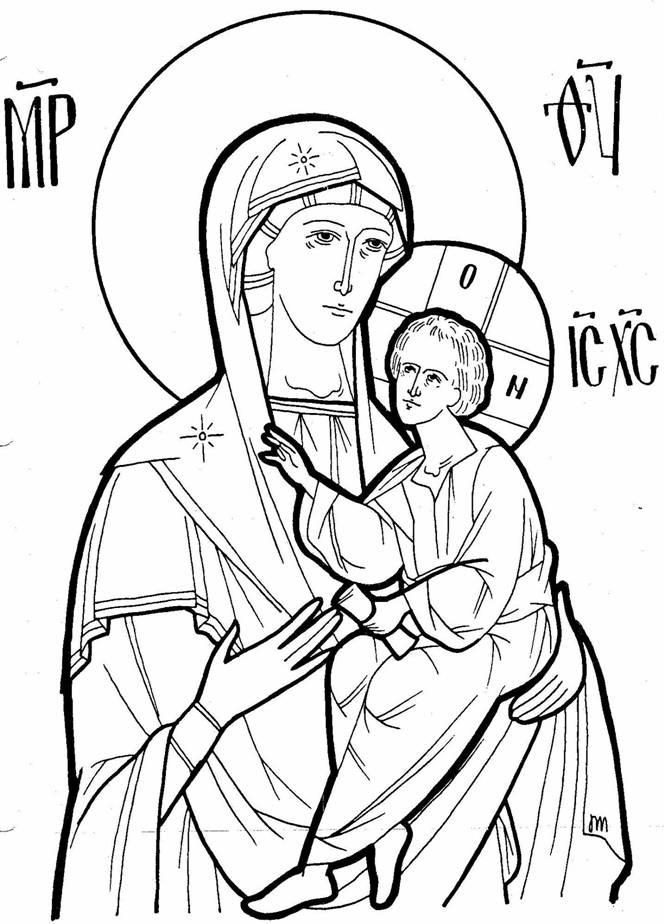
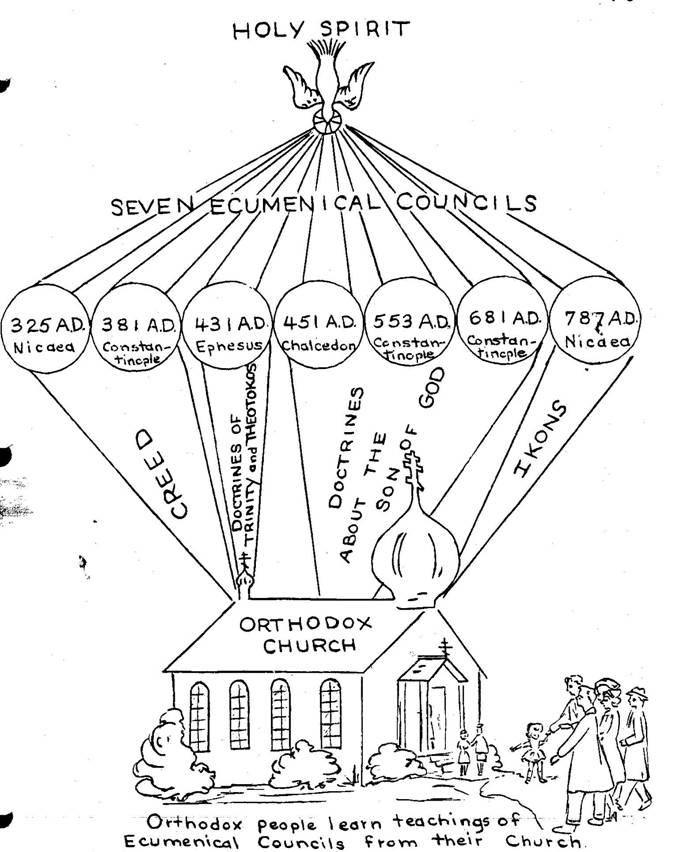
Ecumenical Councils/St. Nina and St. Patrick
Ecumenical Councils/St. Nina of Georgia/St. Patrick
Home Activities
The smallest children, too young to understand the councils, are studying St. Nina, Equal to the Apostles, this week; the older children are learning about the ecumenical councils. The councils may make for dry reading at home, but the stories of St. Nina and St. Patrick can be reviewed for the younger children and told to the older. Nina brought Christianity to the land of Georgia by healing the queen of the land. But, the king would not believe, until one day the sun disappeared and did not return until he confessed Christ.
- Study the sun this week – its make-up, rising and setting, etc. Watch the sunrise or sunset. Imagine with your child the king lost in the forest in the darkness with no sunlight in the middle of day.
- Color the icon for your icon corner.
- St. Nina carried a cross made of twigs. Make a cross of twigs for your icon corner or even to wear.
The middle-size children enjoy the story of St. Patrick this week. But, the older children should also know his story.
- Review it – his capture as a slave in Ireland, his return.
- Why is he pictured with a shamrock and snakes? Make shamrocks – decorate early for his feast day in March.
- Have a “typical” Irish meal, with corned beef, cabbage and Irish soda bread.
- Color his icon for your icon corner.
Prayer: Lord, St. Nina taught us that You are the light of the world Lord, teach us to love our enemies, as did Your servant St. Patrick.

Can you help find the shamrock? What is its meaning?
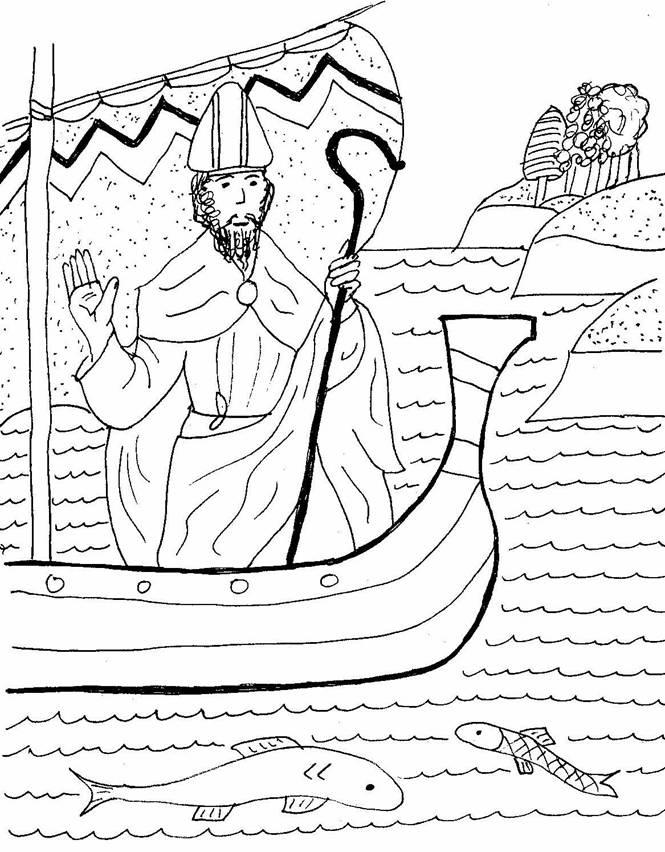
ST. PATRICK, ENLIGHTENER OF IRELAND
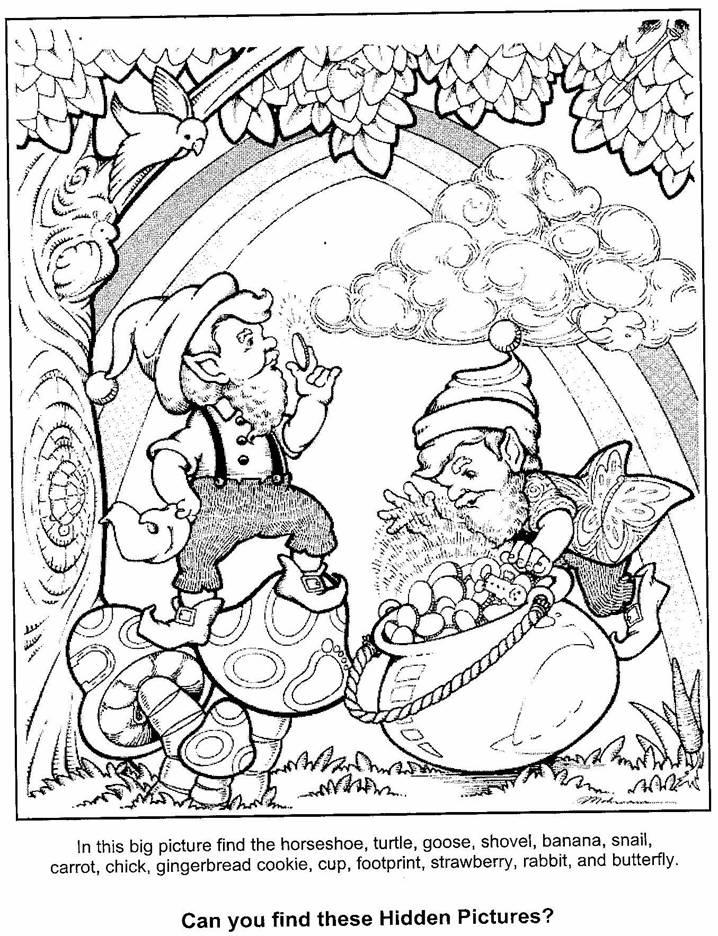
Fall of Rome
Fall of Rome
The fall of Rome was a major event in Western history.
Home Activities:
- Look at pictures of the city of Rome; Dr. Pat has a book at home with pictures as it was then, and as it is now.
- Look at pictures of St. Peter’s and the Sistine Chapel and discuss the themes of the statuary and paintings. Try painting on wet plaster (or white salt dough or play dough); to make it really hard, try doing it upside down lying on the floor with the painting suspended above from a table or chair.
- Several movies come to mind to show the culture of ancient Rome: QuoVadis, the Silver Chalice, Spartacus (or The Gladiator), Ben Hur. Some of these will be shown at Movie nights, but all can be rented for home viewing. They’re most appropriate for older children.
- Learn a bit of Latin; all educated children learned Latin in every century in the Western world until the 20th. It’s still everywhere – on buildings, statues, quotes in books.
- What about Roman numerals; can you use them all week to keep track of your groceries, lunch money, etc.?
Prayer: Lord, no nation is permanent. Bless our own nation and help her to seek your path.
This lesson should fall right around the time of St. Valentine's day, February 14. This would be a great time to remind the children that the holiday is SAINT Valentine's Day and review what we know of his history. There are several ideas at the end of this set of coloring pages.
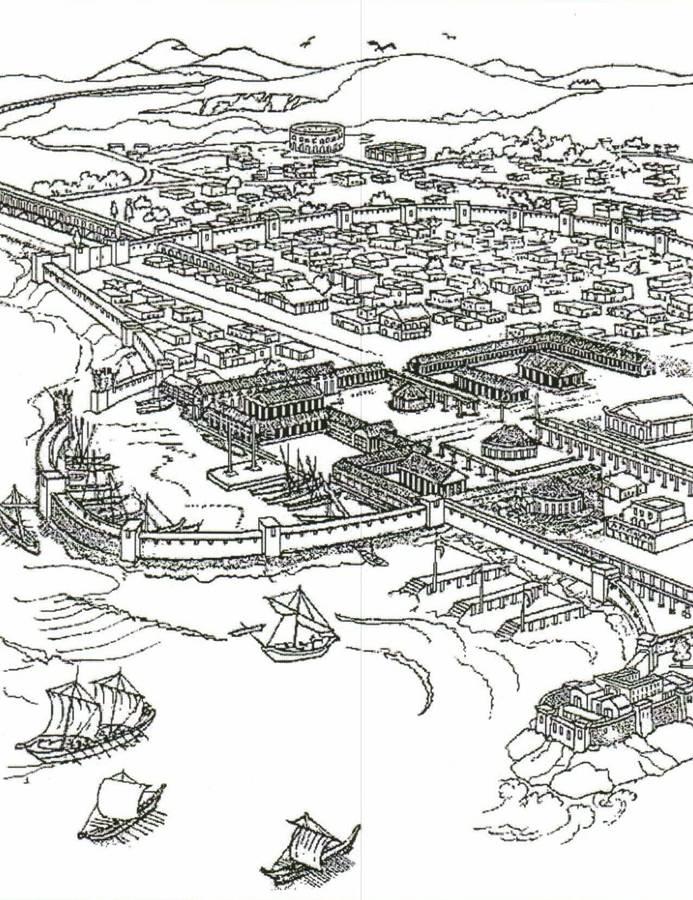
THE CITY OF ROME IN ANCIENT TIMES
Make edible St. Valentines with 3-marshmallow body, Hershey kiss miter, mini chocolate chips or tiny candies for eyes and beard, tiny heart doily for robe, and that candy cane for the crozier.
A wreath for your home for St. Valentine’s day? Cut out hearts and mount on heart doilies and have the children write the definitions of love from I Corinthians 13, I John, and the Gospels on each. Glue together, with center heart with icon of St. Valentine.
Byzantine Empire/Justinian the Great
Byzantine Empire/Justinian the Great
Home activities:
- Look this week at examples of architecture, especially domes. Visit the Roman Catholic basilica downtown for its style.
- Can you visit St. Demetrios Church to see its mosaic work?
- You can do mosaic work at home with seeds or tiles. There are also kits to paint a tile or do a mosaic stepping stone at any craft store.
- Justinian also revamped the entire code of law; visit the courthouse and see how laws are enforced today.
Prayer: Lord, Thank You for the beauty that You allow us to create to glorify You.
What are the characteristics of Justinians’s greatest architecture?
Unscramble each of the clue words.
Take the letters that appear in the  boxes and unscramble them for the final message – its name.
boxes and unscramble them for the final message – its name.
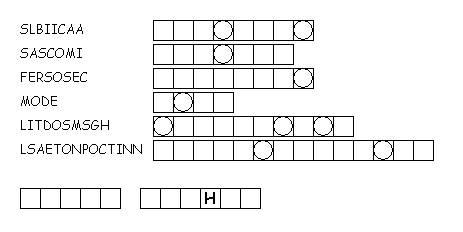
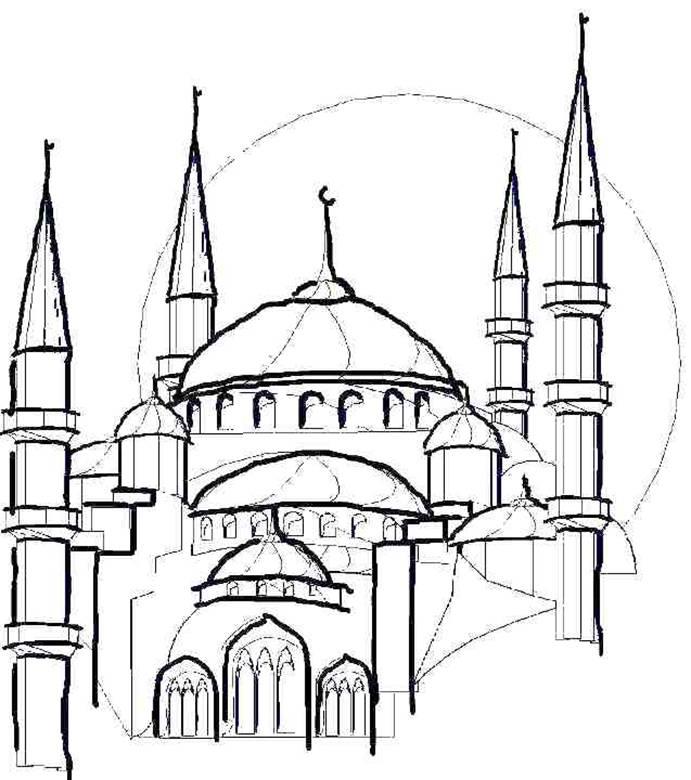
HAGIA SOPHIA TODAY
Rise of Islam
Rise of Islam
Home Activities:
Explore the world of Islam this week.
- Wear a chador (a black sheet with 2 holes for eyes; I have a few); can you get anything done in it?
- No pork this week.
- What about some Middle Eastern or Arabic food for dinner? Recipe for tabouleh and hummus are in the Holy Cross cookbook. The men sit at the table; women and girl children stand until the men finish eating before they can eat. Play some Arabic music while the men eat.
- Look back at the story of Abraham (Genesis) and Ishmael to see the origin of the Arabic peoples.
- With an older child, watch “Lawrence of Arabia” (be sure to be with the child; it needs some parental narration or censoring); a younger child may enjoy “Aladdin”.
- Color the picture of the Muslim warrier on horseback; review on the map the lands conquered by the Muslims in the days after Mohammed.
Prayer: Lord, bring Your gospel back to the lands once rich in Christianity.
Secret code: Can you write a message using these Arabic letters?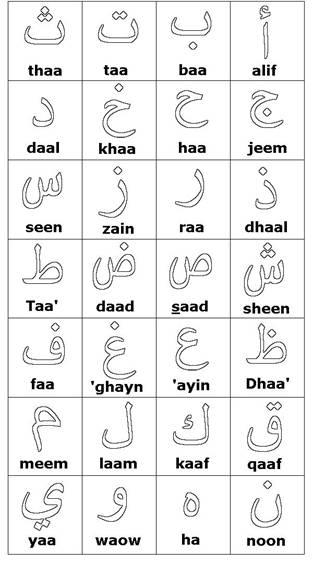
(Note: There are no vowels included.)
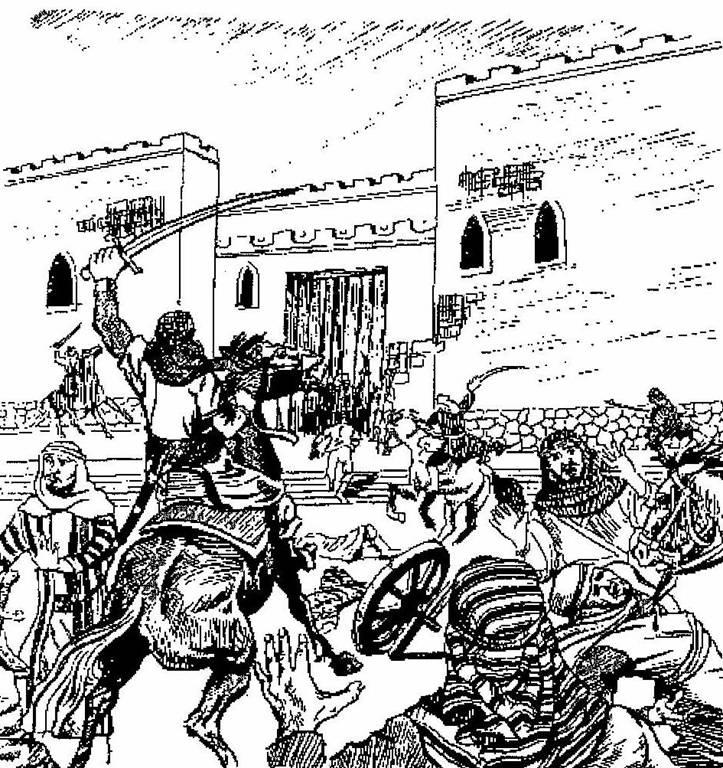
MUSLIM INVADERS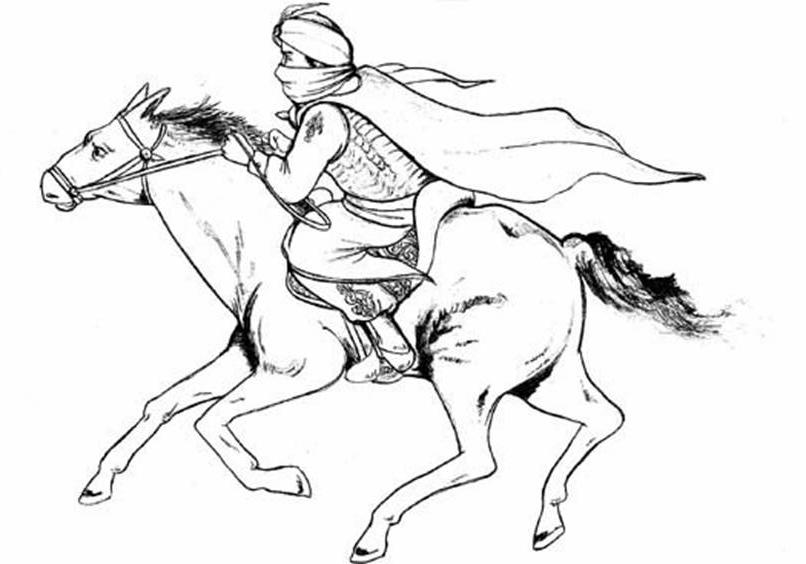
Icons/St. John of Damascus
Icons/St. John of Damascus
Home Activities:
- Icons are important in Orthodox worship. Look at all the icons in your church; what is their purpose and what can your child learn from each.
- Color the icon of the Sunday of Orthodoxy for your icon corner.
- Visit the Walters Art Gallery; look at the icons and religious paintings there. Write (paint) an icon, but be sure to prepare properly with prayer.
- Pray each day facing your home icon corner; if you don’t have one, this would be a great week for you and your child to set one up.
- Does your child have an icon of his name saint; if not, pick one out mounted from the bookstore or a catalog or buy a print and decoupage it with your child. This is easy to do with a wood plaque, painted with acrylic paint, and, after the paint is dry, use Mod Podge to both attach the icon print and then to provide a finish by painting over the print.
Prayer: Lord, thank you for bringing the holy icons back into our churches.
The Triumph of Orthodoxy Crossword
Across
2. Wicked son of Emperor Leo
4. Emperor who began the destruction of icons
5. John's hometown
8. religious pictures to be venerated
9. Empress who called the 7th Council
Down
1. Man who defended icons to the caliph
3. Empress who led the Triumph of Orthodoxy
6. Location of the 7th council
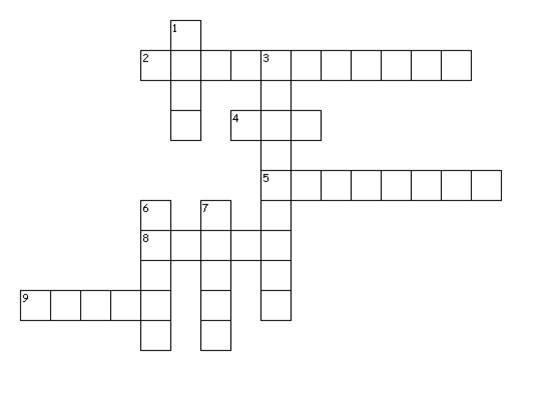 7. holy men who hid icons
7. holy men who hid icons
ST. JOHN OF DAMASCUS AND HIS TEACHER
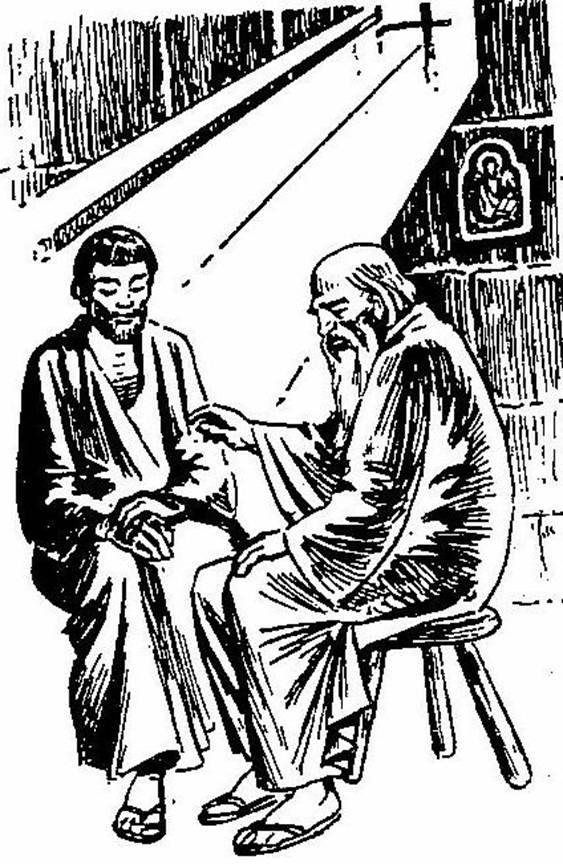
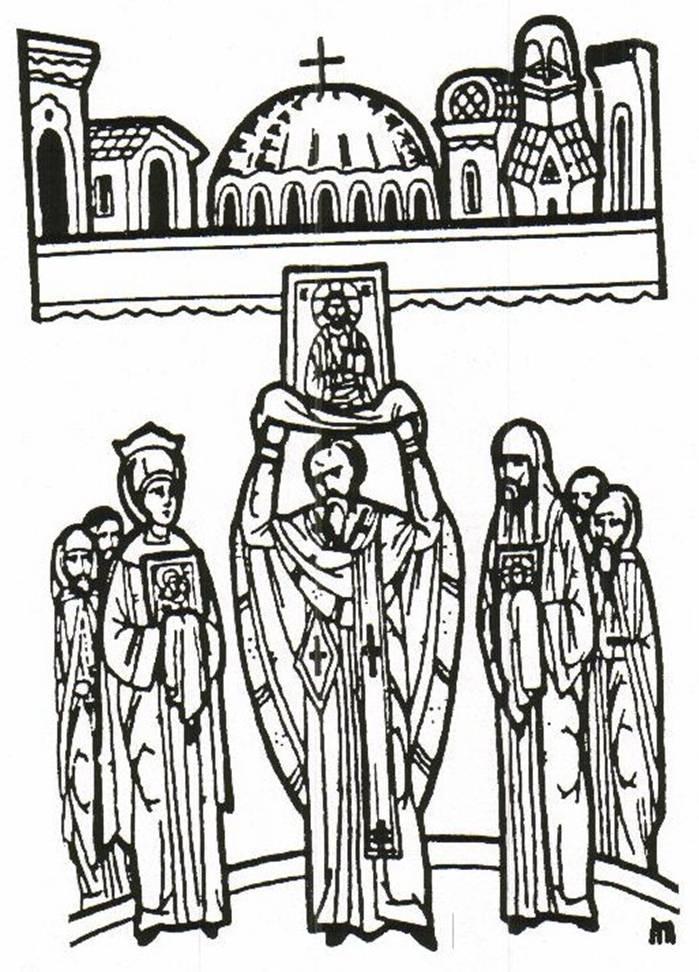
Monasticism
Monasticism/ St. Anthony, St. Gerasimos, and St. Seraphim
We will be studying this week the development of monasticism, with a special telling of the stories of St. Anthony, St. Gerasimos, and St. Seraphim.
Home Activities:
- Reread these stories with your children; at least one of them should be in any book of saints’ lives.
- What a wonderful way to work into Great Lent. Try a monastic week – no TV, services every morning and evening, light diet, prayer and work all day. Have your child wear a “habit”, maybe a bathrobe or a hooded cloak, to remind him that today he is a monk..
- Visit the bears at the zoo and tell the story of St. Seraphim and the bear.
Prayer: Pray each day the prayer of St. Ephraim the Syrian, another great monk, “O Lord and Master of my life! Take from me the spirit of sloth, despair, lust of power and idle talk. (Prostration) But give rather the spirit of chastity, humility, patience, and love to Thy servant. (Prostration) Yea, O Lord and King! Grant me to see my own transgressions and not to judge my brother, for blessed art Thou, unto ages of ages. Amen. (Prostration).
Cyril and Methodius/Baptism of Russia
Cyril and Methodius/ Baptism of Russia
Home Activities:
Have fun with the Cyrillic alphabet this week.
- Even small children can copy the letters and color the pages. Color the icon of St. Cyril and Methodius for your icon corner.
- Older children can begin to write “secret” messages, sounding out the words and substituting the Cyrillic letters for the English ones.
- Or, have your child play missionary, making up an alphabet for an unknown language and “translating” the Scriptures into their new alphabet.
Prayer: Lord, bring the word of Your gospel to all the lands where You are not yet known.
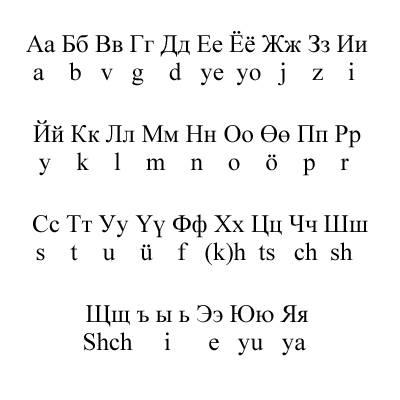
Can you write: “Cyril and Methodius brought the gospel to the Slavs”?
_______________________________________________________________________
How about: “The alphabet used in Russia is called Cyrillic.”
_______________________________________________________________________
Now: “Cyril and Methodius were brothers from Thessalonica.”
_______________________________________________________________________
Saints Vladimir and Olga
Gregory Palamas
St. Gregory Palamas
Home Activities:
- There’s some memory work again this week; even the smallest children should be able to learn the Jesus prayer. Say it every day in your prayer time. The treasure box will again come out next Sunday.
- Color St. Gregory’s icon for your icon corner.
- Try a little mysticism with your older child this week; instead of reading or reciting prayers throughout prayer time, try some time of silence, just focusing the mind on Jesus.
- Doves are also big this week; visit a pet shop to meet a dove or come on over to the Disharoons’ to pet and hold our dove.
- Adorn your house with doves – from construction paper, paper plates, handprint doves, all kinds of doves.
Prayer: Lord, send our spirits to You in heaven on wings like a dove.
What prayer did Gregory Palamas teach us?

![]()
Can you decode the secret message?
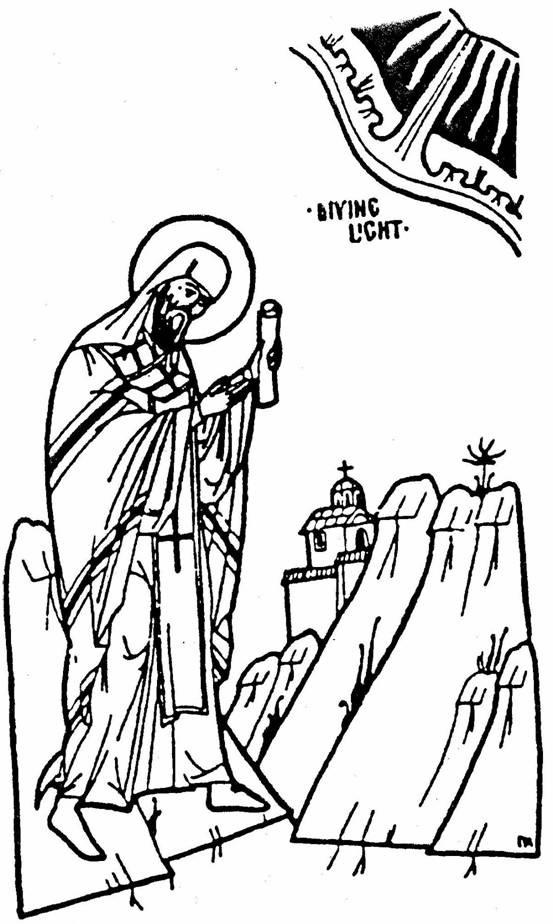
ST. GREGORY PALAMAS
Crusades
The Crusades
Home Activities:
- Time to march again; organize the neighborhood children’s crusade. But, don’t forget to remind your child of the defeat of the crusaders and of the sack of Constantinople; facts left out of many Western histories.
- Is your child’s room a mess? Compare that to the pillaging of Constantinople and see how much time and effort it takes to get all in order again.
- Let your child see you “steal” several of his prize possessions and hide them away; feel the grief and sadness together (then return the “lovies”).
- Visit the Walters again; see the suits of armor and other artifacts from the Middle Ages in the West.
- Build a castle from blocks or poster board.
- Have a “feudal day” with girls dressed in long skirts and tall, pointed hats, boys in armor and shields, no electricity, no silverware except a knife, roast your dinner in the fireplace or over the grill.
- Try a visit to the Medieval Times at the mall. Watch the old “Robin Hood” movie together; Richard the Lion-hearted was gone because of the Crusades.
Prayer: Lord, help us never to hurt others in Your name.
Can you put these events in the right order, 1-16? Try a timeline, complete with pictures:
_____ French children sold as slaves.
_____ Pope Urban calls on Christians to take Jerusalem back from Moslems.
_____ Crusaders steal riches of Constantinople.
_____ Mohammed born in Mecca.
_____ Richard the Lionheart talks to Saladin.
_____ French children march to the sea to board ships for the Holy Land.
_____ Third Crusade with Richard, Frederick, and Philip sets out.
_____ Jerusalem captured back from Moslems the first time.
_____ Richard the Lionheart captured and imprisoned.
_____ People sew crosses on their tunics.
_____ Moslems capture Jerusalem for the first time.
_____ Frederick Red Beard of Germany drowned.
_____ Pirates capture French children at the seashore.
_____ Crusaders build castles in Jerusalem.
_____ Crusaders attack Constantinople.
_____ Saladin allows Third Crusaders into Jerusalem in peace.
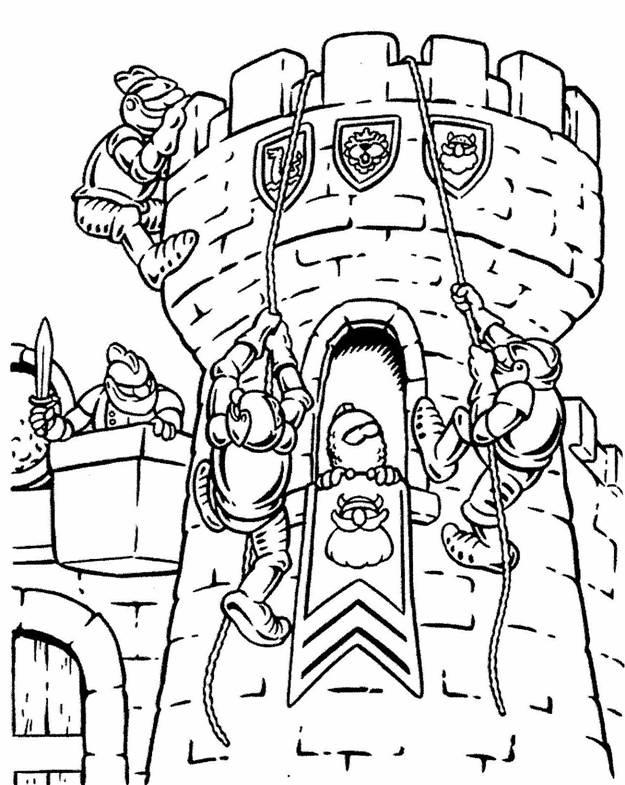
THE CRUSADES
Fall of Constantinople
Fall of Constantinople
Home Activities:
- The result of the Crusades. Build a castle of blocks and knock it down.
- Constantinople was the City of Constantine; review the stories of Constantine, of Helen and the Elevation of the Cross, and of the Fall of Rome.
- “Visit” Turkey in the library; see the culture and the architecture of Constantinople, now known as Istanbul.
- Look at pictures of Hagia Sophia today; what’s missing?
- Try a “harem” day; little girls will love to dress in silk scarves and bathing suits and practice “belly dancing” to music you can pick up at the library.
Prayer: Lord, bring freedom to Your people still struggling in Your great City of Constantine.
The Fall of Constantinople: The City of Constantine
Unscramble each of the clue words. Copy the letters in the numbered cells to other cells with the same number to discover a hidden fact.
- City of Constantine
- Eastern Empire
- Greatest Eastern Emperor
- Turkish General
- Geographical defense of the city
- New invention of war
- Name of new country
- Fate of Haggia Sophia
Protestant Reformation
Protestant Reformation
To cover the entire Protestant Reformation in the West in 2 lessons is ludicrous, but we’ll try anyway.
Home activities:
- Bring out the hammer and nails and join Martin Luther in hammering away on the cathedral door.
- Visit one or several Protestant churches with your older child; most of them have Sunday or Wednesday evening services in addition to Sunday morning. What’s alike and what’s different from a Liturgy? How is a Baptist service alike or different from a Lutheran?
- Interestingly, especially for those who are converts, Orthodox children usually come away from a Protestant service feeling somehow “cheated”; where’s the meat? My children feel like they’ve been to a “show”, with some good (or excellent) music and preaching, but not to a worship experience.
We cannot in any way do justice to this lesson in 2 Church School periods; we depend on you parents for weekday field trips and discussions.
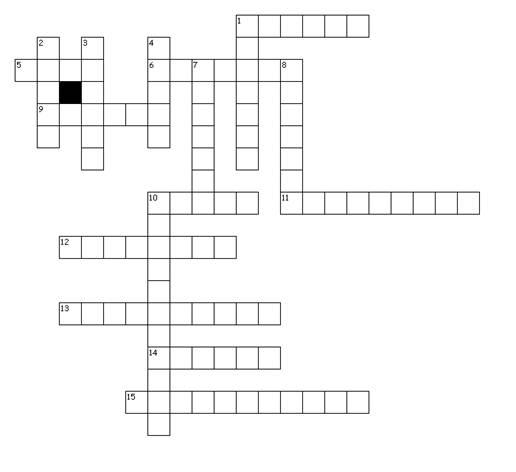 Prayer: Lord, may Your people someday be one, even as You are one.
Prayer: Lord, may Your people someday be one, even as You are one.
The Church is divided:
Across
1. Founder of the Presbyterian Church
5. Sole head of the Roman Catholic Church
6. Home of John Wesley
9. Founder of the Seventh Day Adventists
10. Founder of the Baptist Church
11. Church of England in the USA
12. Believe in adult immersion
13. Cathedral where 95 theses was nailed
14. Monk who wrote the 95 theses
15. Sold by the Roman church to buy time in heaven
Down
1. King of Spain in days of Luther
2. City where Luther was condemned
3. Founder of the Methodist Church
4. Founder of Church of England
7. Home of Martin Luther
8. Issue for which Church of England founded
10. Home of John Calvin
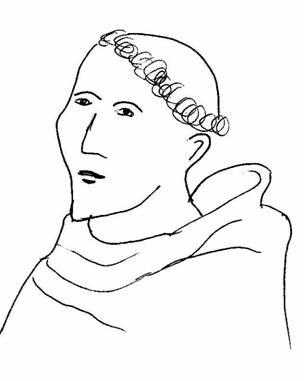 THREE OF THE REFORMERS
THREE OF THE REFORMERS
Martin Luther
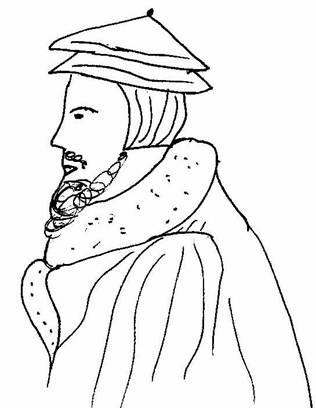
John Calvin
John Wesley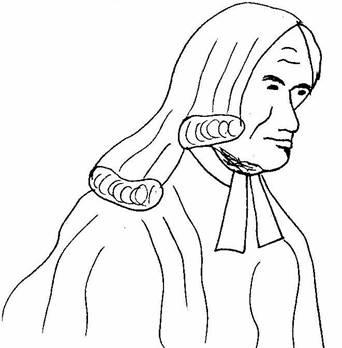
Antioch and Armenia
The next several lessons cover the growth of the national Orthodox churches from the 1500s to the present. As an ongoing project, locate each country on a map of the world or a globe and mark it; learn its capital and geography from an encyclopedia. With an older child, keep watch in the newspaper or news magazine for any mention of these countries in the next few weeks and make a scrapbook.
Armenia/Antioch
Home Activities:
- Buy or paint a T-shirt that tells the world that the word “Christian” comes from Antioch.
- Review the story of the conversion of Saul, which occurred in Damascus, the seat of the Antiochian Patriarchate.
- Learn to sing the “Holy God” hymn in Arabic.
- Go back to the lesson on Islam and work again on your Arabic letters.
- Make some traditional foods, especially for Holy Week when we’re fasting. Hummus is very easy to make in blender or food processor. Just put in 2 cans chick peas (drained), 1 chopped onion, 2 cloves minced garlic, 1 cup tomato puree, ¼ cup lemon juice, 2 tsp ground cumin, ½ tsp. paprika, cayenne and black pepper to taste. After blending till smooth, garnish with chopped parsley.
Prayer: Lord, we pray for all the bishops of the Antiochian Orthodox Church.
PASCHAL MATCHING
Can you match the first half of each greeting with the second?
English: Christ is risen! Voistinu voskrese!
Greek: Christos anesti! Adeverat inviat!
Russian: Christos voskrese! Indeed He is risen!
Arabic: Al-masi-kam! Alethos anesti!
Romanian: Christos inviat! Haq an qaam!
Ethiopia, Alexandria, St. Catherine's, Georgia
Ethiopia/Alexandria/St. Catherine/Georgia
Home Activities:
- Now we’re in Africa for Ethiopia, Alexandria (Egypt), and St. Catherine's. Try some African recipes; get some African music tapes out of the library.
- Look at pictures of ancient Egypt;
- A good time perhaps to watch “The Ten Commandments” and review the stories of Joseph and Moses again in your story time.
- Review the story of Philip and the Eunuch.
- Jesus also went to Egypt; when?
- Ask our own Egyptian family how to say “hello”, “thank you”, and “good-bye” in Egyptian.
- The country of Georgia is included in this lesson. Compare with our state of Georgia -- similarities, differences. Find it on the map -- in Africa or not?
Prayer: Lord, strengthen Your church in Africa where You first led Your Hebrew people out of slavery.
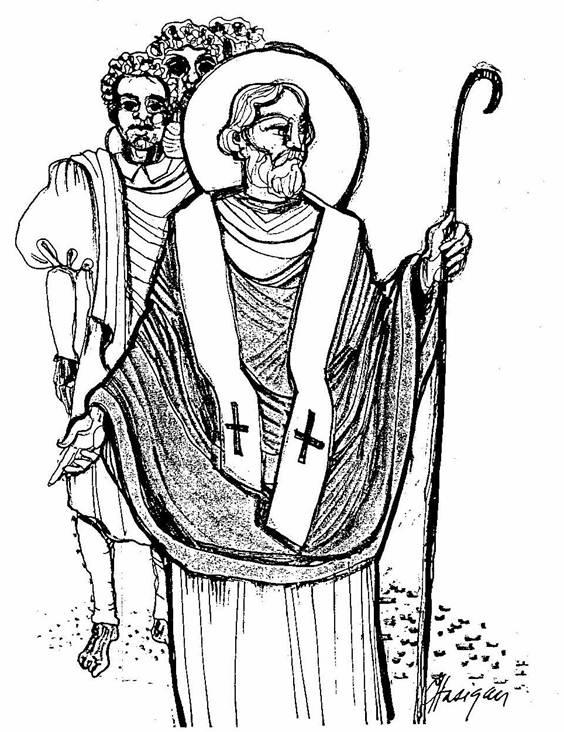 ST. FRUMENTIUS, ENLIGHTENER OF ETHIOPIA
ST. FRUMENTIUS, ENLIGHTENER OF ETHIOPIA
Once there lived a boy in the land of Phoenicia named Frumentius. A rich man named Meropius decided that he would sail to India to learn of the wisdom of that land. Meropius took with him 2 boys, Frumentius and his friend Edesius. But, the ship ran out of food. They came to a town on the coast of Africa and landed the ship to buy food. But the people of this region hated the Romans. They killed Meropius and the sailors and took the two boys to the king as slaves. This is how Frumentius came to the African land of Ethiopia.
The king could see that the boys were smart and well-mannered. He decided to let
them live as his servants. Edesius became his cup-bearer and Frumentius a keeper of scrolls. They served the king well. But, the king died young. The queen asked Edesius and Frumentius to help her young son learn to rule the land and they agreed to serve the people of Ethiopia. Frumentius was now free to travel around the country. He gathered the Christians together and told people about Jesus. Soon, there were more and more Christians in the land.
Greece
Greece/Constantinople
Home Activities:
- Visit a Greek restaurant in Highlandtown; visit a Greek parish for vespers or a weekday service.
- Have some fun with the Greek alphabet just as we did earlier with the Cyrillic. Can you write secret messages using Greek letters to spell the words? Try: “The apostle Paul traveled to Greece and started the church there.”
- Try some Greek food at home (spinach pie, lamb, baklava are all easy to make); your child and his friends can each make his own personal baklava by painting melted butter on a single sheet of phyllo pastry (do this very fast, since until painted the pastry dries up incredibly quickly), sprinkling with a mixture of finely ground walnuts with a touch of sugar and cinnamon, folding each side to the center in thirds to make a long strip, sprinkling again with walnut mixture, and rolling from one end like a sleeping bag. Bake at 350 degrees for about 10-15 minutes, until slightly crispy. While the pastry is baking, mix about 2-3 cups water (depending on the number of pastries) with 4-5 cups sugar to make a slurry, add a cinnamon stick, and heat in a saucepan until all the sugar melts. Add about ½ cup honey and pour over the baked goodies. If they can wait an hour or so to eat, the baklavas will be even better, but if not, let them dip into the sauce that will not yet have soaked in.
- They can also have great fun with Greek hand-shaped rolls called koulourakia: Separate 4 eggs. Beat the whites until stiff, then add the yolks, 2 cups sugar, 1/3 cup orange juice, ¾ cup melted butter or margarine – all while beating constantly. Sift 3 tsp baking powder with 1 cup flour and add to mixer. Then knead in 5-6 more cups flour until you have an elastic bread dough. Give each child a ball and have him roll it into a long snake. Lay on greased cookie sheet in fanciful patterns – snail, octopus, figure 8, etc. Brush with beaten egg for glaze and bake at 350 degrees for 15-18 minutes until golden.
- Try some Greek dancing; get the music out of the library, hold hands with the leader holding a red scarf in his free hand, and with small children just run, kick, and jump like follow-the-leader, making spirals and snakes around the room.
- Learn to say “Christos anesti; alethos anesti” for Pascha.
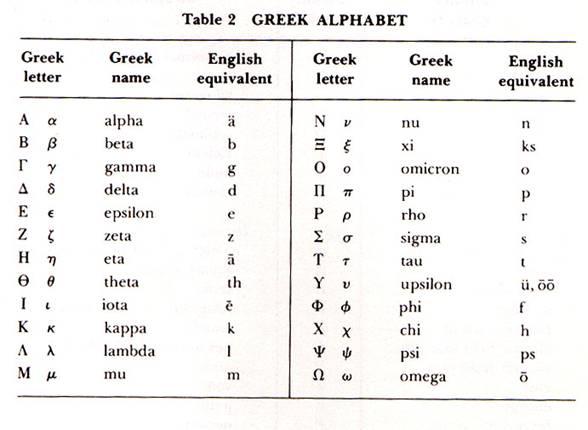 Prayer: Lord, help us to enjoy all the traditions that make Your church so much fun.
Prayer: Lord, help us to enjoy all the traditions that make Your church so much fun.
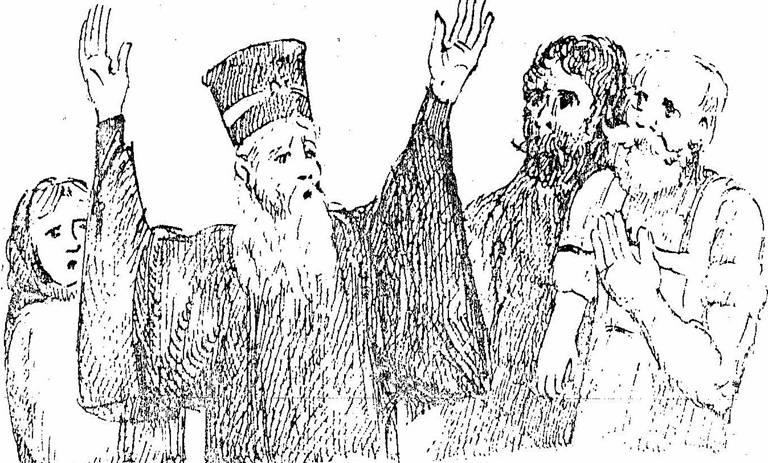
ST. COSMAS AITOLOS
About 250 years ago there lived in the land of Greece a monk named Cosmas Aitolos.
Cosmas lived for 17 years in the monastery on Mt. Athos. But, God told Cosmas to leave the monastery. The Greeks had been ruled for many, many years by the Moslem Turks. Many had forgotten the Lord Jesus. God asked Cosmas to bring His people back to Him.
Cosmas traveled for 20 years all around the land of Greece. He built schools and
churches and gave people crosses and icons. Soon, people heard of this holy man and came to hear him preach. Wonderful things would happen while Cosmas was teaching – a tailor with a withered hand was healed, a rich noble could hear again.
Many times Cosmas had to preach outdoors because of the huge crowds. They would
stick a large cross in the ground where Cosmas was going to preach to let people know. But, one day, a Turkish soldier pulled out one of the crosses. Suddenly the earth shook and the soldier fell down foaming at the mouth. When he woke up, the soldier knew he had been punished for taking down the cross. He put it back up.
But, many of the people, especially of the Jews and Turks, did not want Cosmas to
keep preaching about Jesus. So, the ruler ordered Cosmas to be killed. The soldiers took the old monk and killed him by tying his neck to the trunk of a tree. Cosmas is also called “Equal to the Apostles” because he brought the Greek people back to the Lord.
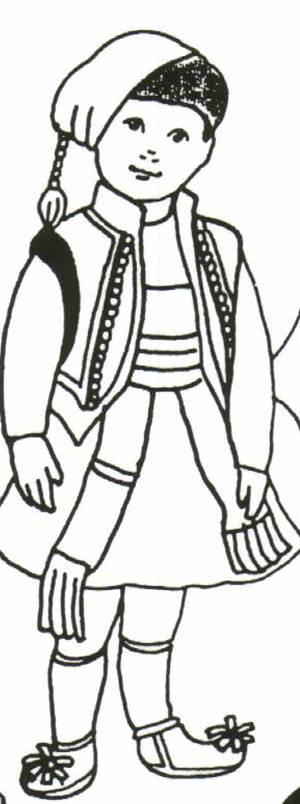
VASILIOS IS FROM GREECE
Serbia, Romania, Bulgaria
Serbia, Romania, Bulgaria
The music, food, and dancing of these countries are not as well-known as the Greek.
Home Activities:
- Review the stories of the great saints of these churches – Sts. Sava, Lazar, and Zlata. Your child should have heard these stories in Church School.
- Color the icons for your icon corner
- We have several Romanian and Serbian families in our own parish who could share their culture with your children.
- Find the countries on a map of Europe.
Prayer: Lord, bring peace in this region and to Your people there.
Serbian Macaroni
Try this in place of macaroni and cheese:
2 pounds ground beef browned with 1 medium chopped onion. Then add 1/3 cup parsley flakes, salt and pepper, and 2 tablespoons butter. Stir and add 2 small cans tomato sauce, 1 small can tomato paste, along with each of the cans filled again with water. Add ½ tsp garlic powder, 1tsp. cinnamon, and 1/3 cup sugar. Simmer 30 minutes and serve over macaroni.
ST. SAVA OF SERBIA
St. Sava was the first Archbishop of the Serbian Orthodox Church, but he was also a humble monk. The following story tells of his wisdom and humility:
One day, as the devil was walking down a steep mountain path, he saw the good and
gentle St. Sava, a priest of Serbia, coming up the path. St. Sava greeted the devil warmly and asked him what he would like best to do. The devil answered, “I would like to grow vegetables, if you would help me.”
So St. Sava and the devil became partners. They decided to grow onions. Soon there
were beautiful green shoots coming up all over the field. Since they were partners, St. Sava asked the devil which half he would prefer. The devil answered, “I’ll take the half above ground and you can have the part under the ground.” St. Sava agreed. Soon the onions were ripe. Above ground were dried up stalks, but underground were beautiful red onions!
The devil was furious. Next they grew cabbages. The devil insisted on having the part under the ground this time. St. Sava again agreed. Soon the cabbages were grown. St. Sava cut the beautiful heads above ground; all that was left was the brown roots underground for the devil.
Now the devil was even angrier. They decided to grow potatoes. The devil asked for the part above the ground. And, again, the devil got worthless leaves, while St. Sava had a crop of beautiful underground potatoes.
Next they decided to grow wheat. The devil chose the underground part, and Sava was happy to get the beautiful yellow stalks of wheat. The devil was left with worthless stubble.The devil was in a terrible rage. St. Sava crossed himself and the devil vanished from sight, never to return to match wits with such a good and godly priest.
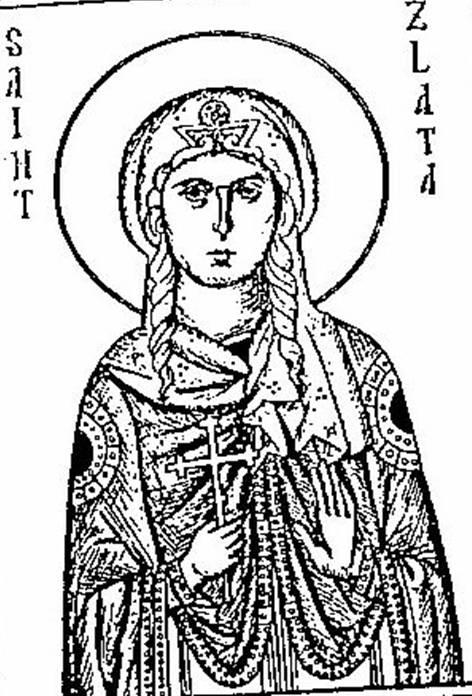
Zlata lived in the village of Slatina in the country of Bulgaria. She was very poor, but loved Jesus with her whole heart. She was also beautiful and kind. All the village loved Zlata.
In those days, the Moslem Turks ruled Bulgaria. They hated all Christians. One day, a Turk saw Zlata as she was gathering firewood for her family. He decided he wanted her for his wife and captured her. He took her to his home. There he decided she must first become a Moslem before he could marry her. But Zlata would not deny Jesus Christ her Lord.
The Turk promised Zlata riches and slaves to do her work for her. But, she would not deny Christ. Then the Turk threatened her with terrible tortures, but she told him she was not afraid to suffer for Jesus. Then he had her live for six months with his Turkish women; they tried to trick her into denying Jesus and even tried magic. But nothing would get Zlata to deny Jesus. The Turk then went to her family and told them they would all be killed if she did not become a Moslem. They tried to get Zlata to at least pretend to be a Moslem, but she told them that she would not lie to God.
The evil Turk was beaten. He tortured Zlata, but all she did was pray. The Turk was furious. He hung her in a tree and cut her into pieces. So St. Zlata became a martyr and went home to heaven with her beloved Jesus.
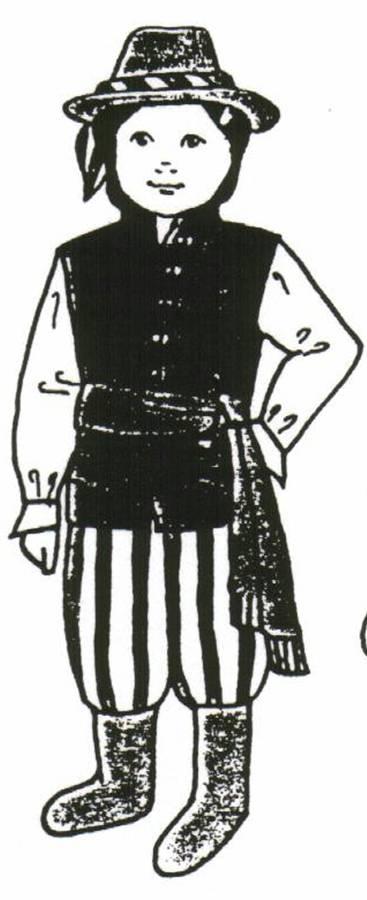
GEORGI IS FROM BULGARIA
Japan
Japan
Home Activities:
- Review the story of St. Nicholas, Evangelizer of Japan.
- Have a Japanese tea ceremony with little girls – green tea, chopsticks, Japanese food, fans, silk scarves all make for a great afternoon. There is an Oriental grocery in Catonsville that will have everything you need.
- Make pearl necklaces; stringing beads (in this case, bags of pearls can be purchased at any craft store) is always fun for small children.
- With an older child, watch “Shogun”, but be sure to watch it with the child and provide commentary or skip the more “adult” portions.
- With an older child, you can also try sushi or visit a Japanese restaurant; this is quite different from traditional Chinese fare.
- Can you learn to say “hello”, “thank you”, and “good-bye” in Japanese?
Prayer: Lord, we thank you for the work of your great evangelizer, St. Nicholas of Japan.
St. Nicholas of Japan Crossword
Across
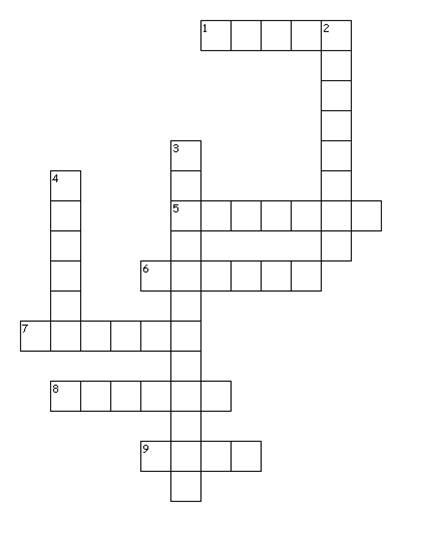 1. Where John was called as a missionary
1. Where John was called as a missionary
5. the warriors of Japan
6. What happened to Fr. Nicholas's first convert
7. Fr. Nicholas's first convert
8. the religion of the samurai
9. The birth name of St. Nicholas of Japan
Down
2. John's name as a monk
3. First cathedral in Japan
4. John's birthplace
ST. NICHOLAS, ENLIGHTENER OF JAPAN
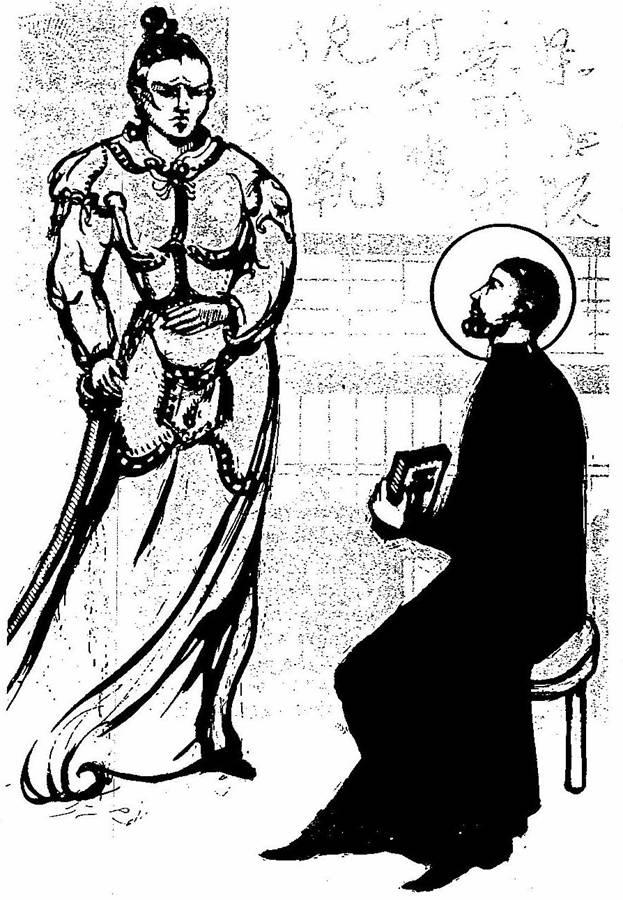
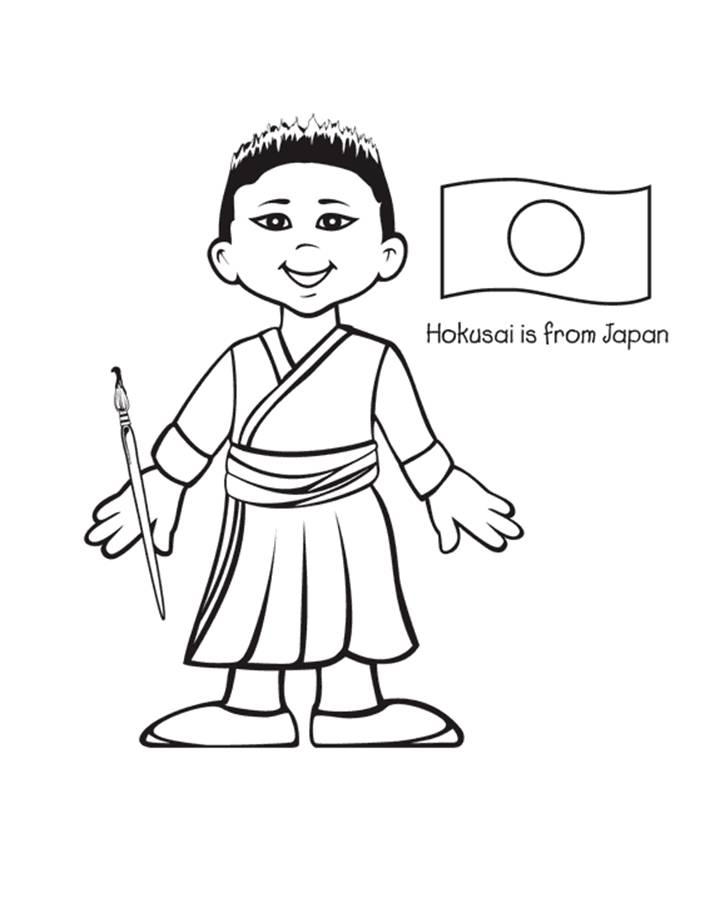
Russia, Ukraine, and the OCA
Ukraine, Russia, OCA
Still more ethnic adventures.
Home Activities:
- Review the stories of St. Sergius, St. Innocent (Apostle to the Aleuts), St. Herman, and St. Peter the Aleut.
- Visit the library or the Internet for books on Eskimos and Aleuts; look at pictures of Alaskan scenery, igloos, seals, walruses, etc.
- Visit these animals at the zoo.
- Now travel to Russia – try a dinner of cabbage, kielbasa, pierogies (Mrs. T’s are easy), beets, etc.
- Visit one of our Russian parishes – St. Andrew’s OCA or Holy Trinity Russian Orthodox.
- Time to pull out that Cyrillic alphabet again and practice some Russian words; just wait till you try “hello”, “thank you”, and “good-bye” in Russian!
- Learn your Pascha responses in Russian as well; plenty of people in our parish or another can help you.
- This is the last lesson and a good review for the family would be a "Saints of North America" centerpiece. Print on cardstock the ship of the Ark of Salvation and the two strips of saints we've studied. Use a paper towel tube covered with "Saints of North America" to balance the Ark of Salvation over the base of the saints, folded to make a fan and taped together. Cut a slit in the top of the paper towel tube to insert the ship.
Prayer: Thank you, Lord, for bringing the good news of Your holy faith to us in America from Russia with your saints Innocent, Herman, and Peter.
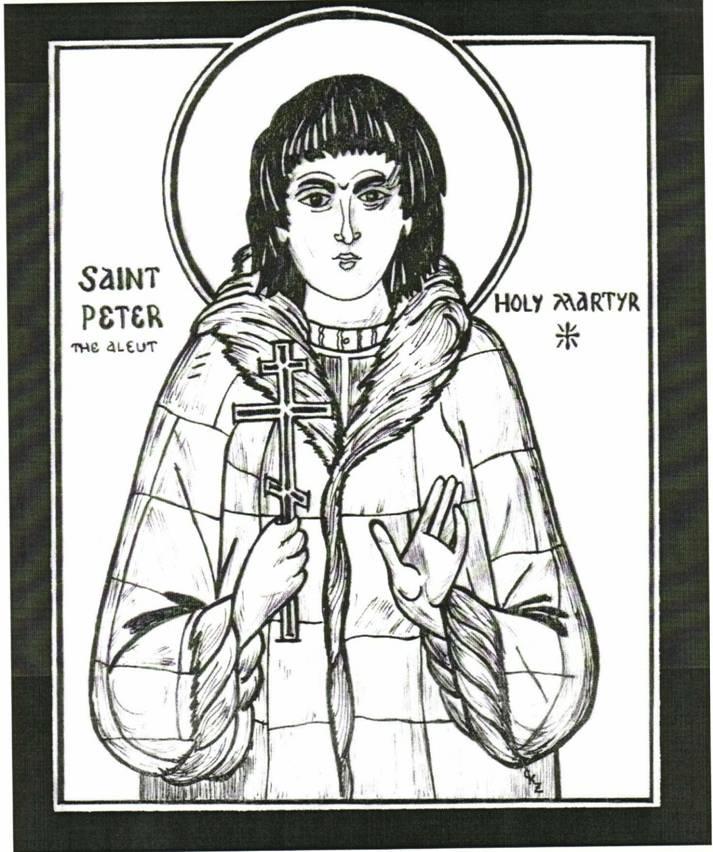
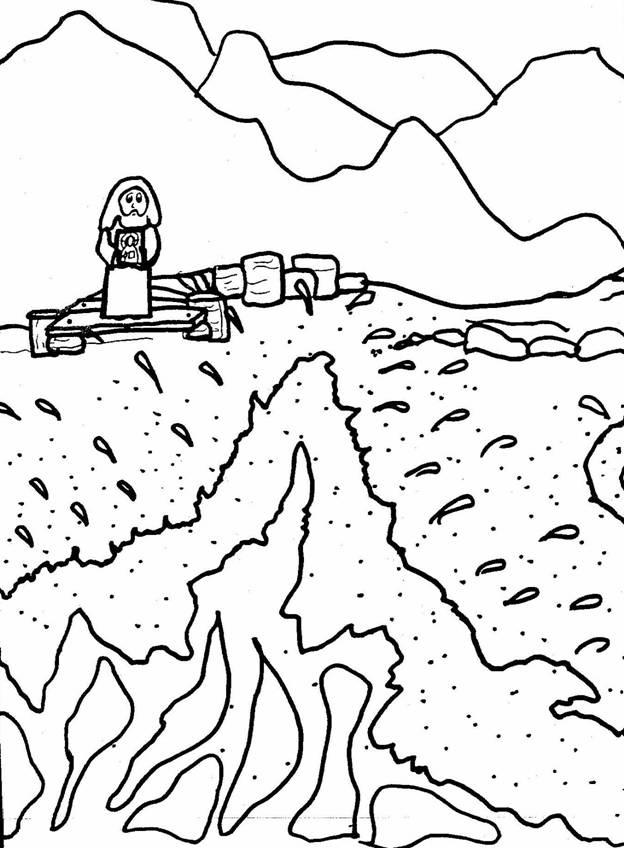
ST. HERMAN OF ALASKA
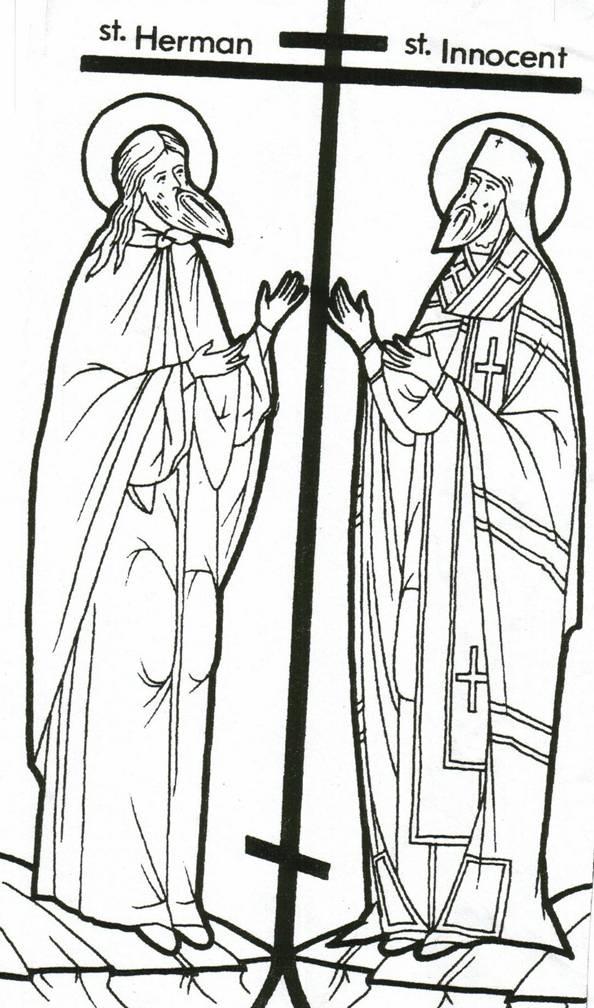

NATASHA IS FROM RUSSIA
